-
My 2025 year-end post
It’s that time where everybody has their two cents to offer on what their year has been about and this post is pretty much the same. Some years I’ve been really good about this and others not so much, but we’re here now and I’ve been writing this on and off for the past month so let’s go for it.
Health
2025 brought on the rude realisation that I am getting older and as a consequence injuries have become quite apparent to me. Back in mid-December of last year, I fell and twisted my ankle while de-boarding a train in London. Basically the heels I was wearing while en route to my office there gave way when I miscalculated the drop between the train and the platform.
Mind the gap I know, but it was 7:30 AM and I was half-awake at best. I had gotten off at this station numerous times in the past so it was just pure inattentiveness.
When I twisted my ankle, I felt something odd in my knee as well but paid no mind since the pain was acute in my ankle. However, as time went on, I noticed my knee giving out as I would walk around and then eventually it became aware that it was a problem when I attempted to play a single game of softball and had a slip up during a play, and thus a hospital visit and then an MRI a week later led to an outcome that required intervention.

The incident in London and the fall during the softball game had accelerated an injury I was bound to have happen. It of course had to happen to my right knee down from my right hip that I injured in roller derby six years ago.
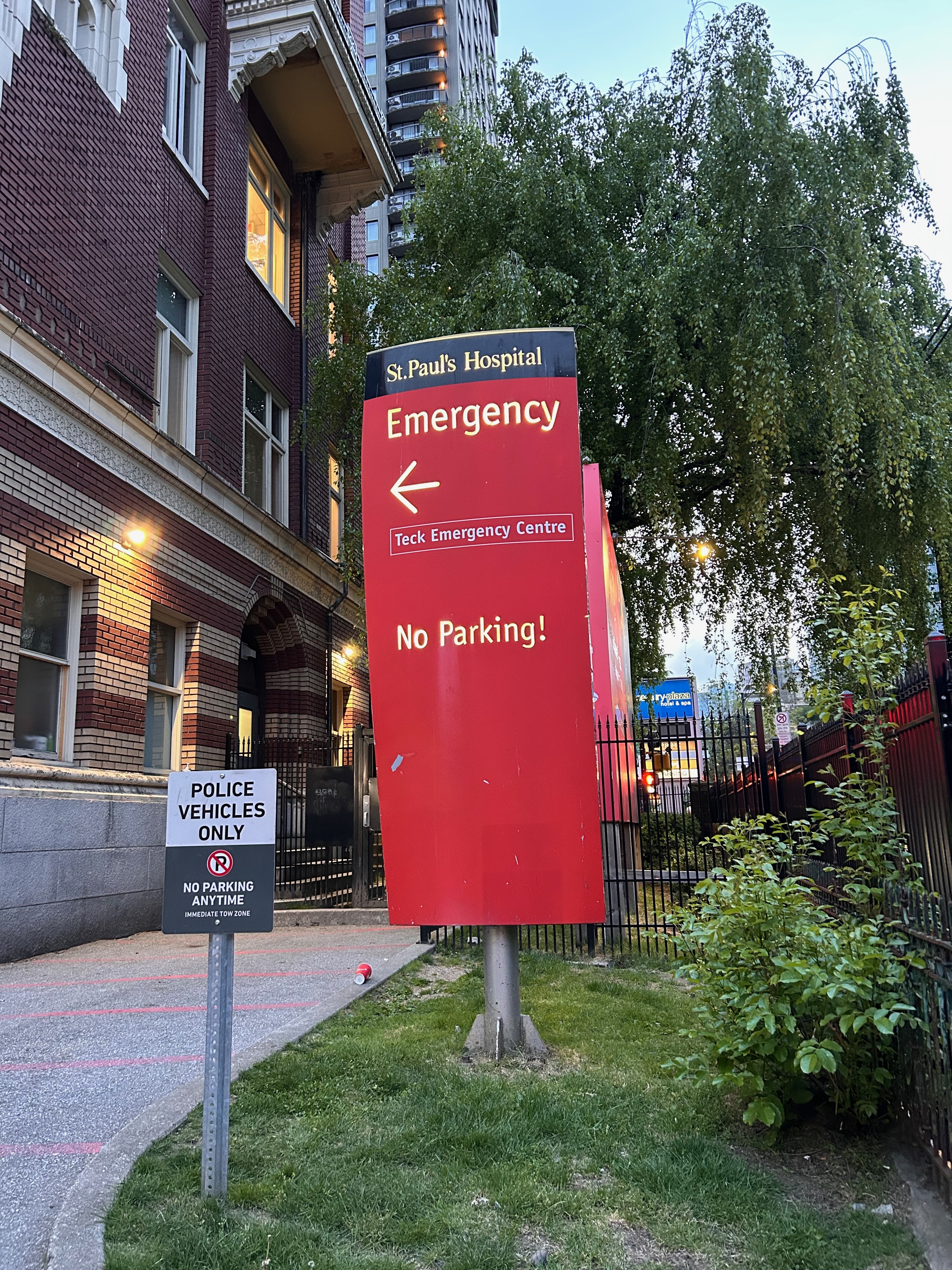
I fortunately was able to avoid surgery and had temporary relief through a procedure that required ultrasound to guide an injection. I was able to get back into some level of physical exercise once more with significantly less pain.
A few months after, trying to return to running and also through playing curling for the first time, I noticed that the pain has returned albeit a lot less worse than the past.
I’m giving myself some time to adjust, but I am considering speaking to the surgeon again to see what my options are since I still from time to time have knee pain that is uncomfortable.
The whole ordeal reframed some views I had about my life. For now, I am hesitating to write more about this part, but I am happy with the decisions I made even if they were difficult.
Travel
I did not fly on an airplane in 2025. Figure that one out.
There are travel plans for 2026, but this year due to the above health challenges and other factors, I opted to not travel much further than Vancouver Island or the Sunshine Coast.
Please enjoy these two photos from my travels:

This is a view from the inside of the provincial parliament building in Victoria, British Columbia. I had an opportunity to be at the legislature during a sitting so I watched some members of the BC Conservative party actually act inappropriately. Shocking I know, but par for the course with these folks.
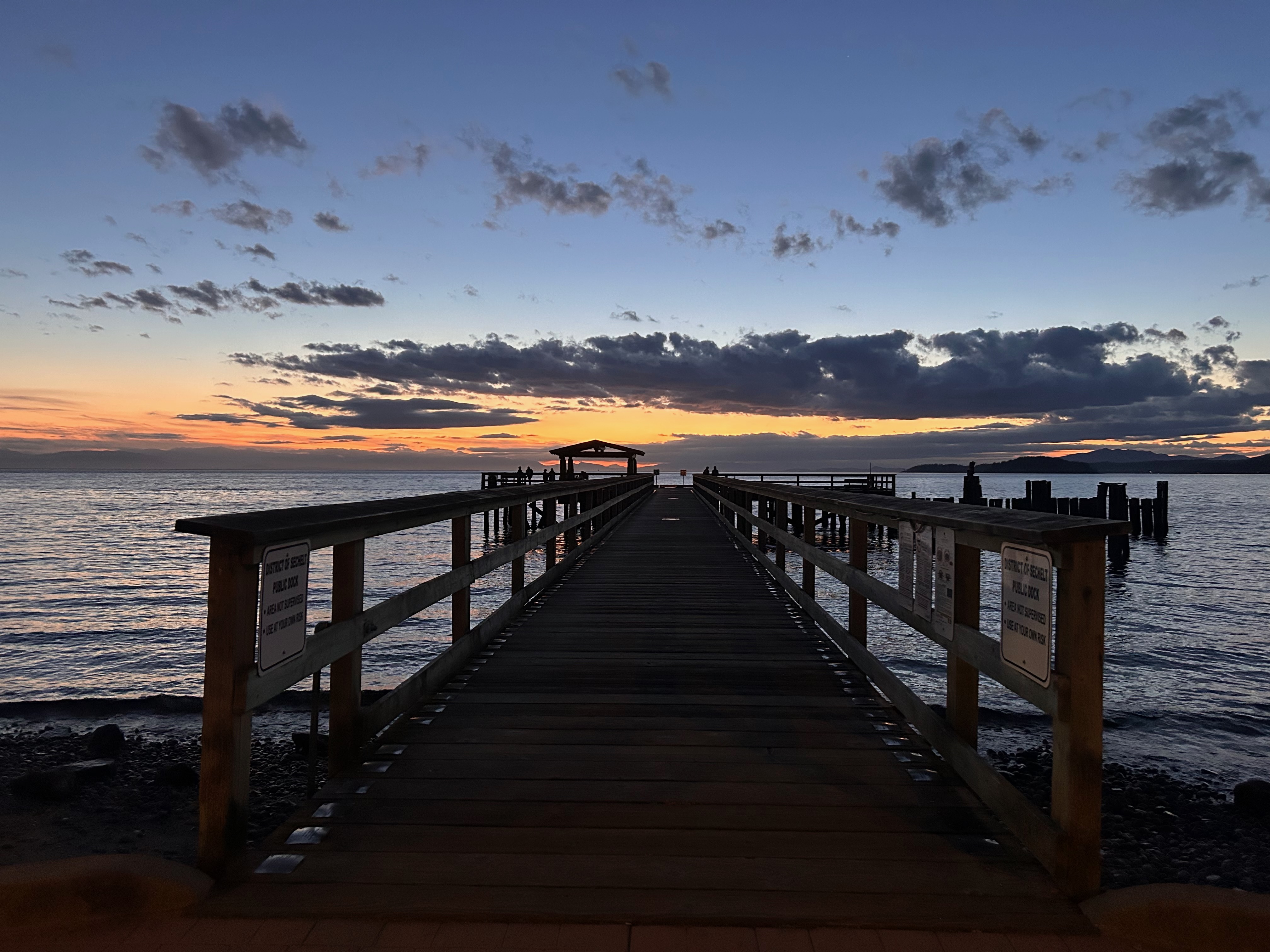
My partner and I took a trip to Sechelt as a getaway for my birthday. We were graced with this lovely sunset just as we were about to go out for a nice dinner.
In any event, in 2026, I am likely to return to Ireland to see some family and then maybe a visit elsewhere. I have been toying with going to Australia at some point, but I feel like that may be a 2027 idea instead.
Photography
This year, I returned to photography, but I have sort of shunned anything digital.
Back in 2024, I purchased a Fed 3, which is a rangefinder made in Ukraine when it was still part of the Soviet Union. I wrote about

Above you can see the following cameras in order from left to right:
- Sony DSC-HX99
- Fed 3
- Nikon D50
- Nikon F60
The D50 is quite old, but I keep it around because it attaches to my 15 cm telescope. I don’t need much in the way for that since the telescope itself does not have a tracking mount so the exposures are never going to be long.
The Sony camera is a leftover from when I streamed and I wanted a camera I could use to get a better shot of my face back when streamer-specific cameras were hard to come by.
I’ve written about my use of the Fed and the F60 in a previous entry, but of the two, the F60 has been the most fun since it’s ready to go and it also doesn’t have a damaged lens.
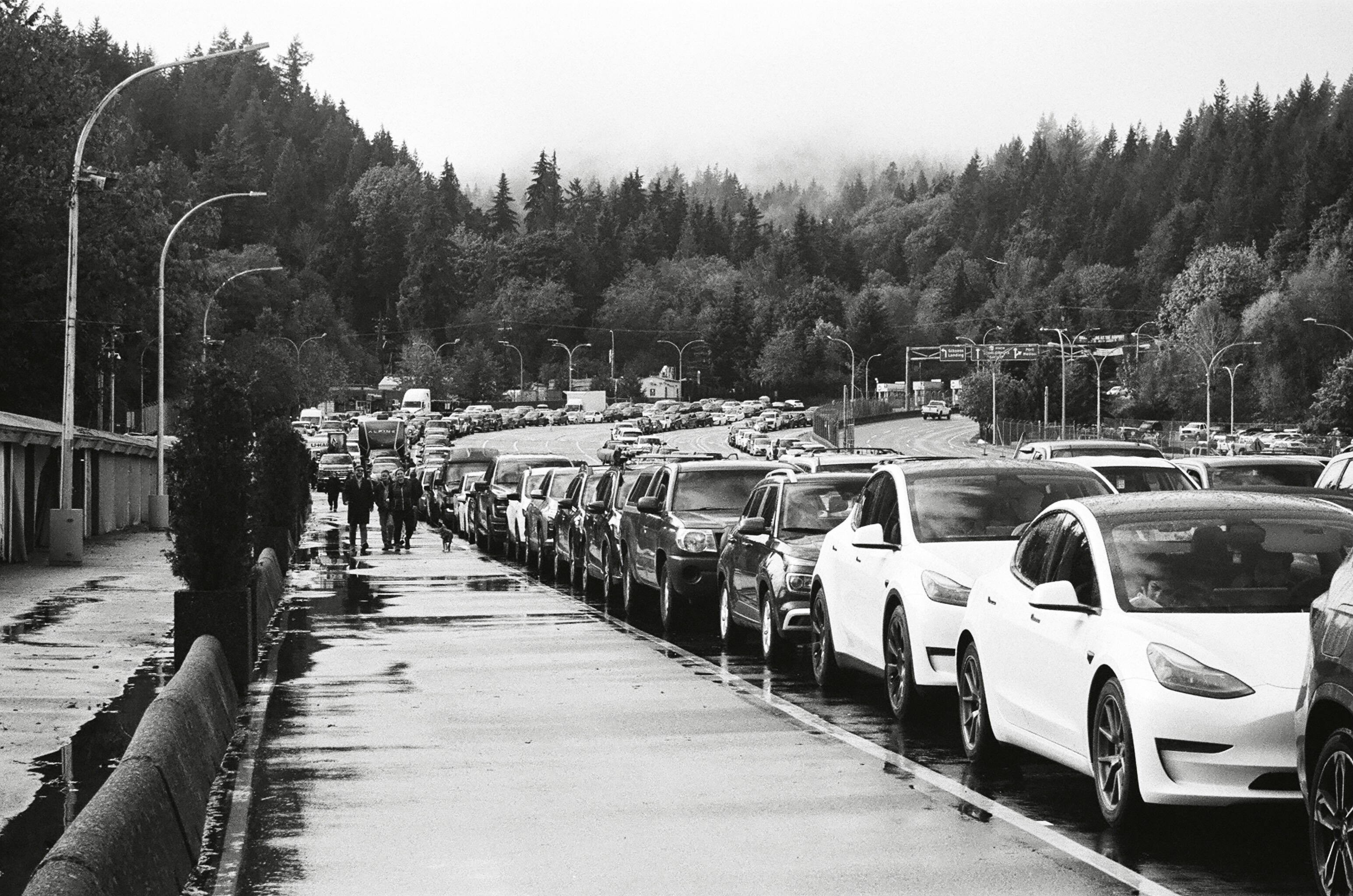
I’m going to make a commitment to document all the film I ever used. I am presently on the hunt for a specific variety of expired film stock of which I will eventually post about once I have what I need.
Media consumption
Let’s talk about some media I enjoyed this past year.
Films
I watch about one to two films per week and if you’re ever curious, I do my best to track them on Letterboxd, which has indicated to me I had ticked over the thousandth film mark at some point in the past year or so.
For films I watched at the cinema, it’s a tie between Mickey 17 and the Phoenician Scheme in terms of favourites.
Robert Pattinson playing a weird little guy (or series of guys I guess) alongside a very psychotic character portrayed by Mark Ruffalo in a science fiction setting did draw me in. However, I am a sucker for almost anything by Wes Anderson and so I am not going to choose here–Asteroid City was a much more enjoyable film for anything recent that said.
However, for films that were no longer on the big screen, I did finally watch Conclave. As someone who was raised Catholic I did notice a huge infraction which might be noticeable if you’re familiar with the sacrament of confession. That said, I enjoyed the movie and have recommended that others give it a watch.
I always have a favourite dumb movie of the year and that goes to War of the Worlds, starring Ice Cube. It was ridiculous, but it was ridiculous and dumb in a way that while I will never be interested in watching again, I can recommend it if you ever need a ride that almost goes nowhere and I mean that literally.

Oh yeah. I also finally watched United Passions. What a godawful movie. It’s a good thing that FIFA and the World Cup is not rife with corruption any more am I right?
Television
I started to watch What We Do in the Shadows and I can say that enjoyed it.
Television has been something I’ve watched a lot less of lately, but that and getting through more of Foundation and also The Expanse have both been a pleasure.
Dropout has continued to be a favourite subscription service and I imagine that it will remain the case into 2026. Game Changer was extremely intense this past season and I can only imagine that Sam Reich will drop the gloves in 2026. I have mixed feelings on Crowd Control and feel that it is at best a two season series.
Books
Sticking with The Expanse, I read through the first three books this year and it has been a very pleasurable experience.

As for other books, I finally read Artemis and have gotten through most of Project Hail Mary, both of which are by Andy Weir.
I’m going to buck the trend here based on some comments I’ve read elsewhere in that I really enjoyed Artemis and think that it could have been made into a series, but Project Hail Mary really just isn’t clicking with me and I feel like it is not at all a better story.
I ended up putting the book down for now, but I am fearing that my annoyance with the style of writing in it might stall me from completing it much the same had happened with God Emperor of Dune by Frank Herbert. It at least didn’t irritate me as Hyperion by Dan Simmons–I’ve been told that the rest of the series is worth a read but one scene in this book turned me off and I’ve been hesitating to come back to it.
Runner up for books I enjoyed goes to Three Body Problem by Cixin Lin. The book really throws a curveball at you until you get to the very end. However, the gender politics really grinds my gears, but looking past that I find that the premise is really good and I might give it a go at the follow up book sometime next year.
I also have read three of the four books from the Wayfarer series by Becky Chambers. Sometime in the new year I’ll read the final book of the series and perhaps write an entry here about my thoughts about her world building. It’s a good series and I suggest giving it a go.
I’m finally going to start reading some Pratchet books in 2026 as well.
Video games
Believe it or not, I don’t think I played anything new released this year.
I have a huge backlog of games and it is ever-increasing. In fact, I opted to pair down my physical collection of games earlier in the year and I feel like that was the right decision.
Stardew Valley was a fun little highlight of the year and a game I keep coming back to for cozy playthroughs.

My hope for 2026 is that Capcom announces a new Ace Attorney game of some sort. If the above is indication enough for my love of the series, I can tell you that I was annoyed to hear that a new Mega Man game was announced and yet a much better series is languishing.
If I were to cast a magic wand, I’d want a follow up to The Great Ace Attorney Chronicles.
I’ve started to play through Final Fantasy XIII this past month. My hope is to finish it before the new year and then move on to XIII-2 and then Lightning Returns. Slowly but surely I am completing every mainline Final Fantasy game.
Music
I attended no concerts this year!
As for new music releases, Chappell Roan’s The Giver was a bop and seeing everybody use it for things such as hockey reels or government messaging really throws me for a loop considering its lyrics are explicitly queer.
Either some people have a sense of humour or it is straight people being oblivious.
Advocacy
I become both a volunteer and a donor to a local transit advocacy group, MovementYVR.
For us to tackle matters such as climate change and also to help ease and maybe assist the housing crisis, I really feel that we need to devote resources towards expanding public transit in our cities. It annoys me to no end that intercity bus service in this province is fragmented at best and non-existent at worst and this idea that we must get everyone to use a car instead is both short-sighted and insane.
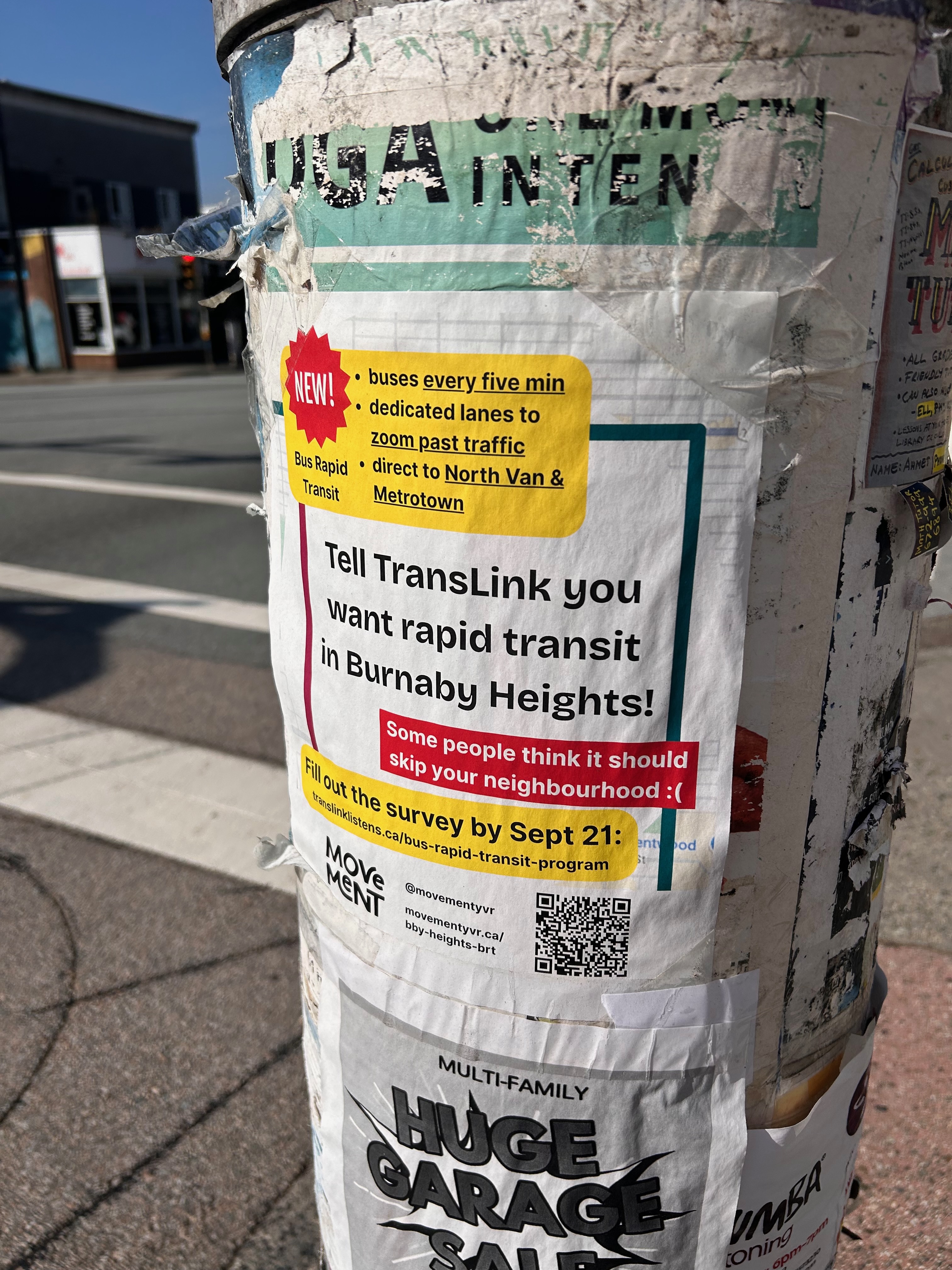
During the campaign to bring bus rapid transit to North Burnaby, the misinformation from the Burnaby Heights Association and its members and supporters really grinded my gears. It is hard to read it as being either ignorance or intention (or both I guess), but they were the most disappointing group of people to contend with since joining.
It really taught me a lot about how ingrained some folks are with the silos they place themselves within.
Transit improves mobility for everyone including those who prefer to drive automobiles. I’d rather go somewhere by transit than take my car. I own an electric vehicle and I still don’t see it as the future nor a mode I want to choose as my second or third option.
My dream for 2026 is to see the an announcement for the Millennium Line extension to the University of British Columbia and some sort of intercity transit service–be it rail or bus.
As a result of my involvement with this group, some other projects are forthcoming and I am excited that sometime in January I’ll be announcing a project I am working on with folks I met through this organisation.
My book
Okay. I am just going to say this here: I am writing a science fiction novel. This has been an ongoing project since 2022 and after many rewrites I have gotten down the premise I am happy with.
The challenge I’ve found with writing a book is unlike short stories I have written in my past, I need to ensure continuity and thus as you go further along it’s easy to accidentally contradict what has happened previously or straight up develop a plot hole.
I won’t elaborate much about the story just yet, but I’m looking forward to sharing teasers from it once I am comfortable enough.
Finding space to write the book has been my largest challenge. I find that writing at home is distracting so often I go to the pub or a cafe to work on it. However, while there, I feel time-limited and I often end up downing too much to drink in the process.
I switched from an Alphasmart to a Remarkable 2 this year though. A friend offered his to me and after purchasing a keyboard attachment for it, it has really proven to be an invaluable device for distraction-free writing.
The book is being written without the aide of any large language models. Even if it is a terrible story, it at least came from my own terrible brain.
Sports
I watched a lot of soccer this year. I am considering to get season tickets for Vancouver Rise FC since I am glad to see a professional women’s club in this city.
I also watched live cricket for the first time this year. The sport makes perfect sense to me now and I kind of wish we were more serious about it in this country but alas.
Next year, the World Cup will have seven games here in Vancouver. I am on the fence about going as while I would love to see some matches, the cost is prohibitive and supporting FIFA is always a moral conundrum.
I started to play curling just in the past month and intend to continue playing in the new year. My injury is making me hesitate to play softball when the season begins, but I think I have a strategy will permit me to return albeit with a reduced capacity.
I’m fucking stubborn and so I won’t let this stop me.
Podcasting
Yes. Shawinigan Moments is coming back.
Tam and I have been busy with our lives. In my case, the injury took a lot of wind out of my sails and that is why the railway series was never completed.
And that series won’t be. The research part of the podcast is quite difficult when you have a day-job and also desire to maintain a social life. I want this show to remain fun for the two of us so we have to approach it all differently.
We’re coming back, but with content we’ve already been doing in the past but was limited to behind the Patreon paywall. We’re also still looking for someone to be our third, which I think would make our show work so much better, but that is a task suited for sometime later in 2026.
Staying on podcasting, I am going to be a producer and editor for another podcast due to be announced next month. This was a meeting of two minds and it’s shaping up be something potentially strong due to the two hosts involved. I will write more about it once there is more to be said so stay tuned.
Closing off with predictions
I want to see how badly I predict 2026 so here we go outlandish or not:
- Prime Minister Mark Carney will get a majority government through someone crossing the floor either from the NDP or the Tories–he only needs one more seat (realistic)
- Pierre Poillievre finally resigns as leader of the Tories (probable)
- One of the large language model companies will die off but more capital will be burnt in order to keep the whole shitshow afloat (probable)
- The Steam Machine is given an MSRP of C$1,600 but would have been cheaper if memory prices didn’t suddenly cost a fortune (probable)
- Some sort of modern ternary computer will be demonstrated but unfortunately it will be for LLM nonsense purposes in mind (unlikely)
- Metal Gear Solid 4 will get a modern port to the PlayStation 5 and PC platforms (possible)
- Dune: Part Three will incorporate a lot more from Children of Dune than Messiah (likely)
- Corus Entertainment will stop being a zombie corporation with being purchased by TELUS (realm of possibility)
- Square-Enix announces a remake of Chrono Trigger using the same engine used by Octopath Traveller or Live A Live (realistic)
- Former Prime Minister Justin Trudeau and American pop star, Katy Perry who have been dating since the springtime will announce that they’re getting married (possible)
When I do my 2026 post, I’ll see how poorly I predicted the year.
-
Photos taken with Harman's Red 125
All of these photos were taken using Harman’s Red 125 35 mm film. I bought this on a whim with the feeling that I would really like the output of this film; I was completely right.
Using my Nikon F60 with a Nikkor 28-80 mm, I took photos during my trip to the Sunshine Coast of British Columbia during the middle of October 2025. I also took some shots on some Kodak 400TX, but it was at the tail end (literally at the end of the trip while we waited for the ferry back to Vancouver), so I’ll leave it for another post possibly before year end.
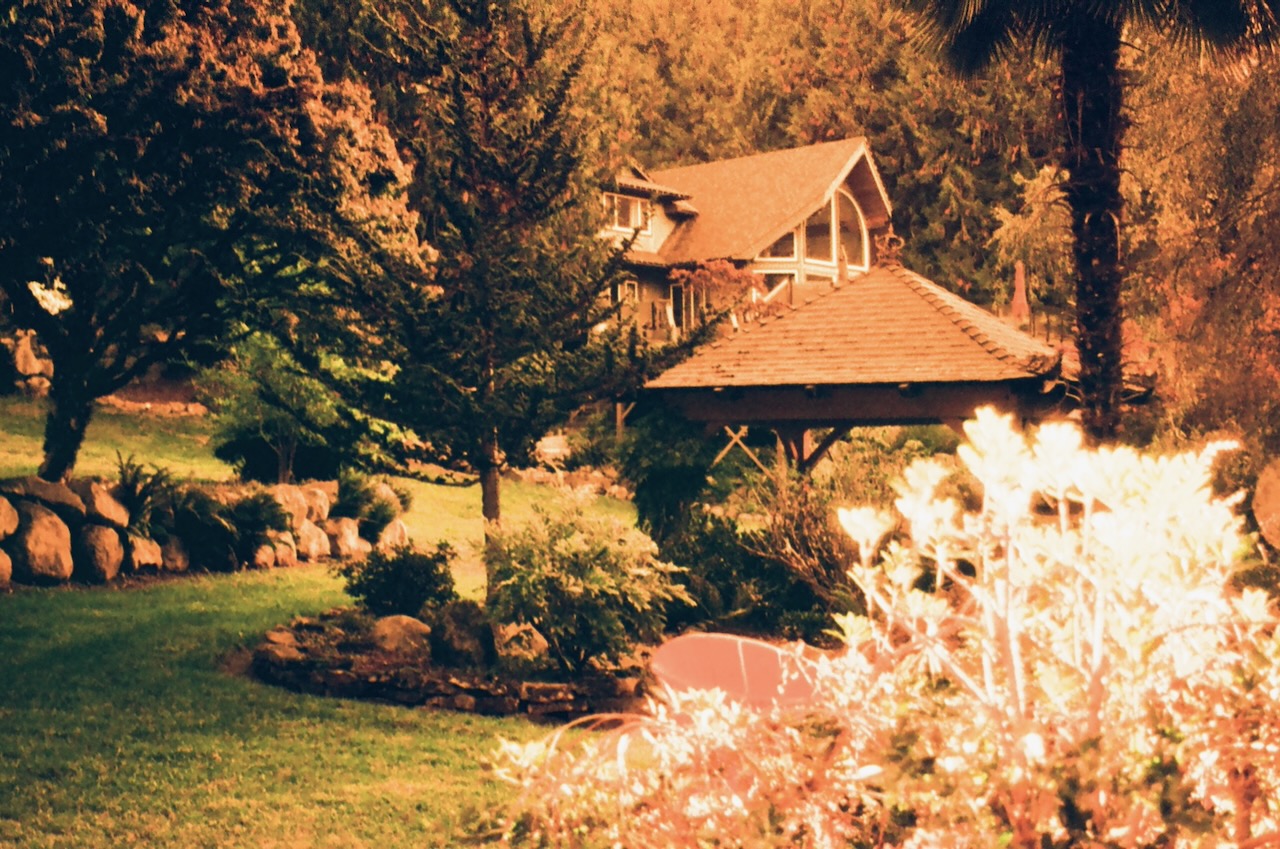
What I really liked about this photo is that while it implied that it was a redscale film, it showed a spectrum of colours which permitted white, black, green, and of course red. The above photo showing a house on an estate was taken from the porch of the cottage we were staying at.
The above is one of my two favourite shots taken with this roll.
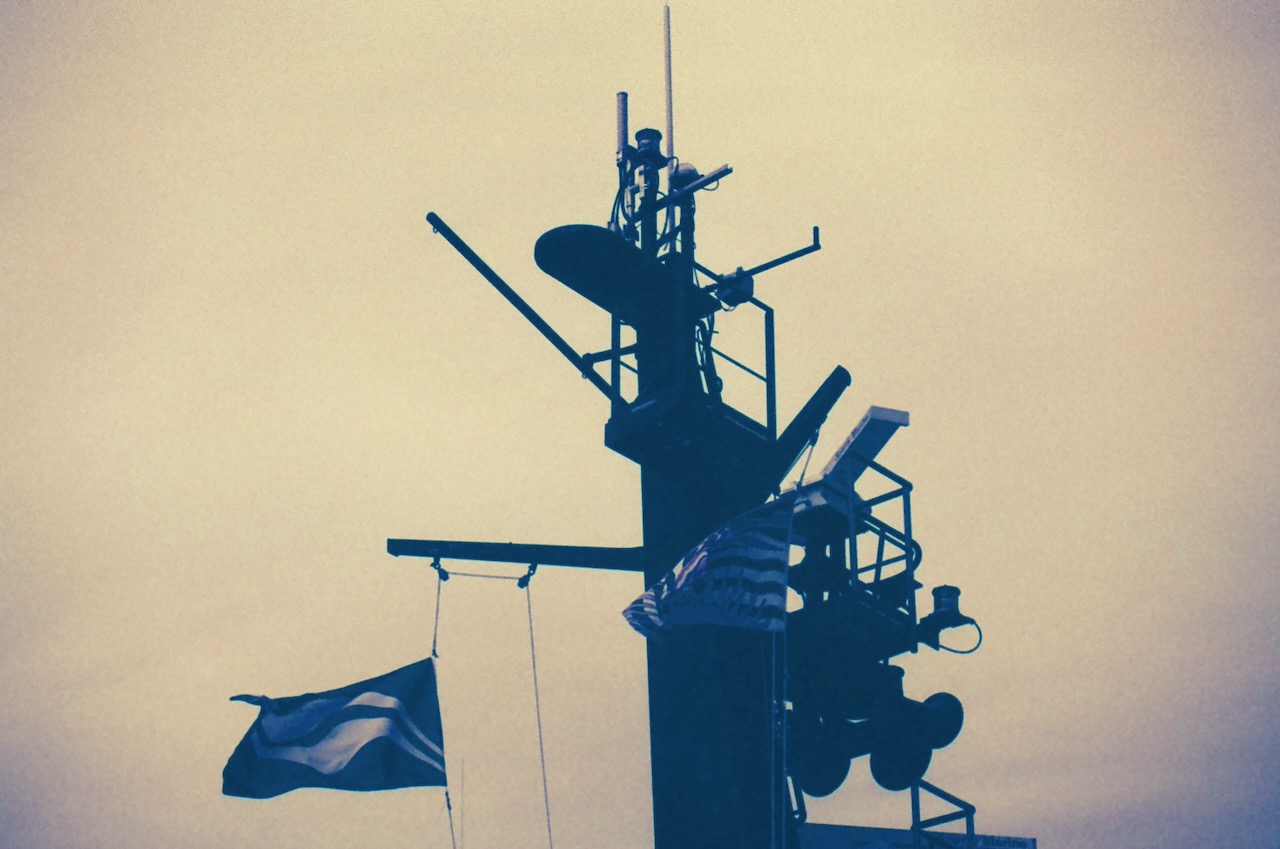
I took a photo of the mast of the ferry we took between Horseshoe Bay and Langdale. What really is cool here is that it shows a blue tone that I haven’t been able to figure out why since Harman doesn’t suggest it has this colour in its spectrum.
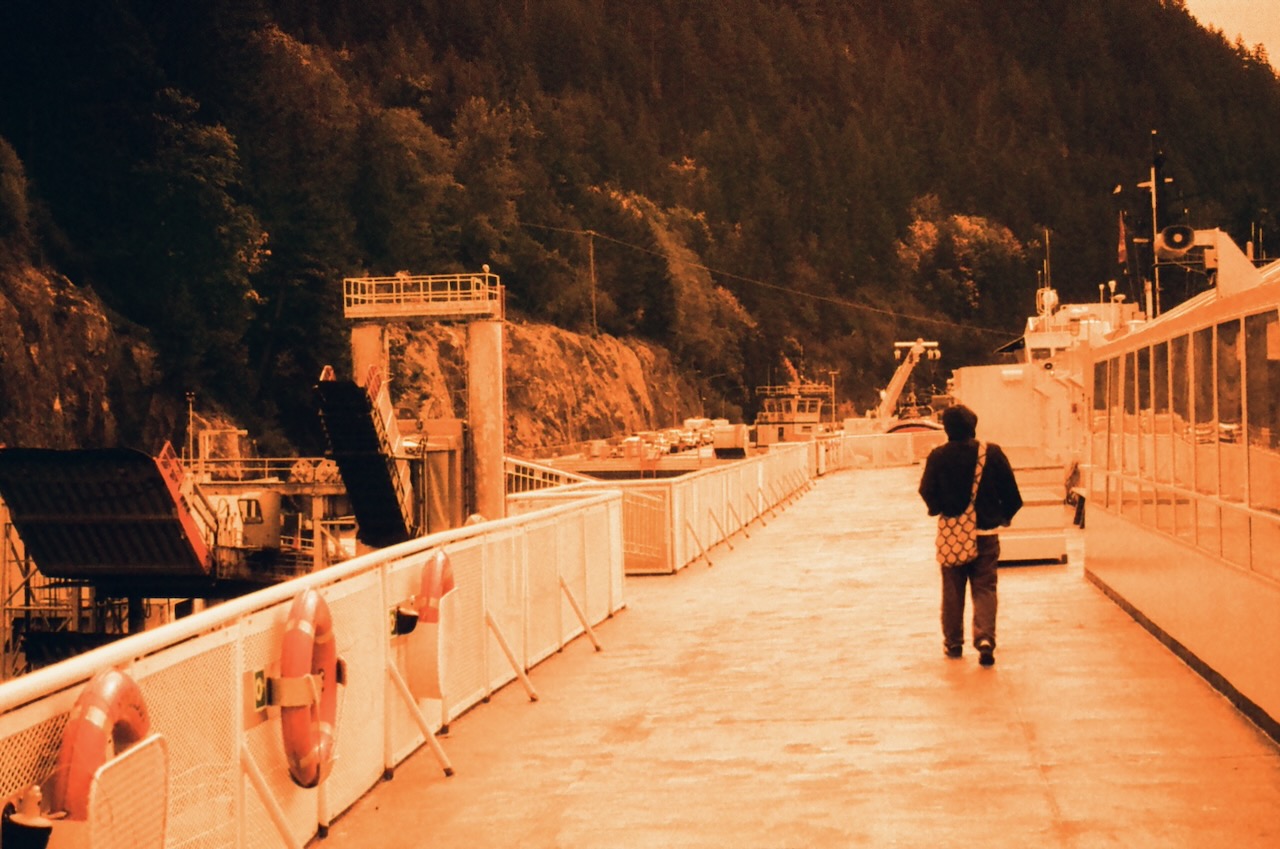
This is the most pure example of the redscale film in action–the reds are quite apparent here. This was as the ferry left Horseshoe Bay.
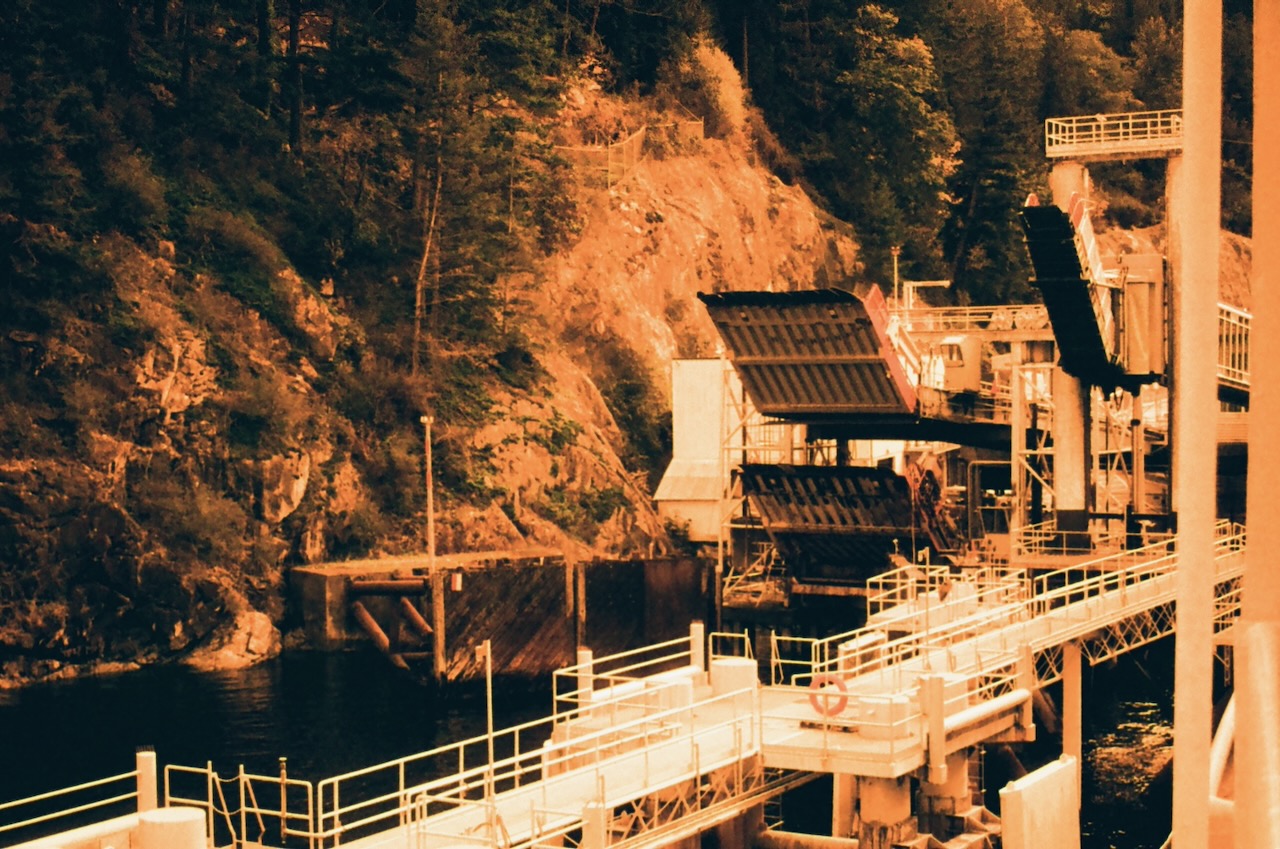
One of the pedestrian bays on the top-right really shows an intense black, but this is just a consequence of scaling down and then encoding in JPEG. In any event, you once again can see the greens leaking through.
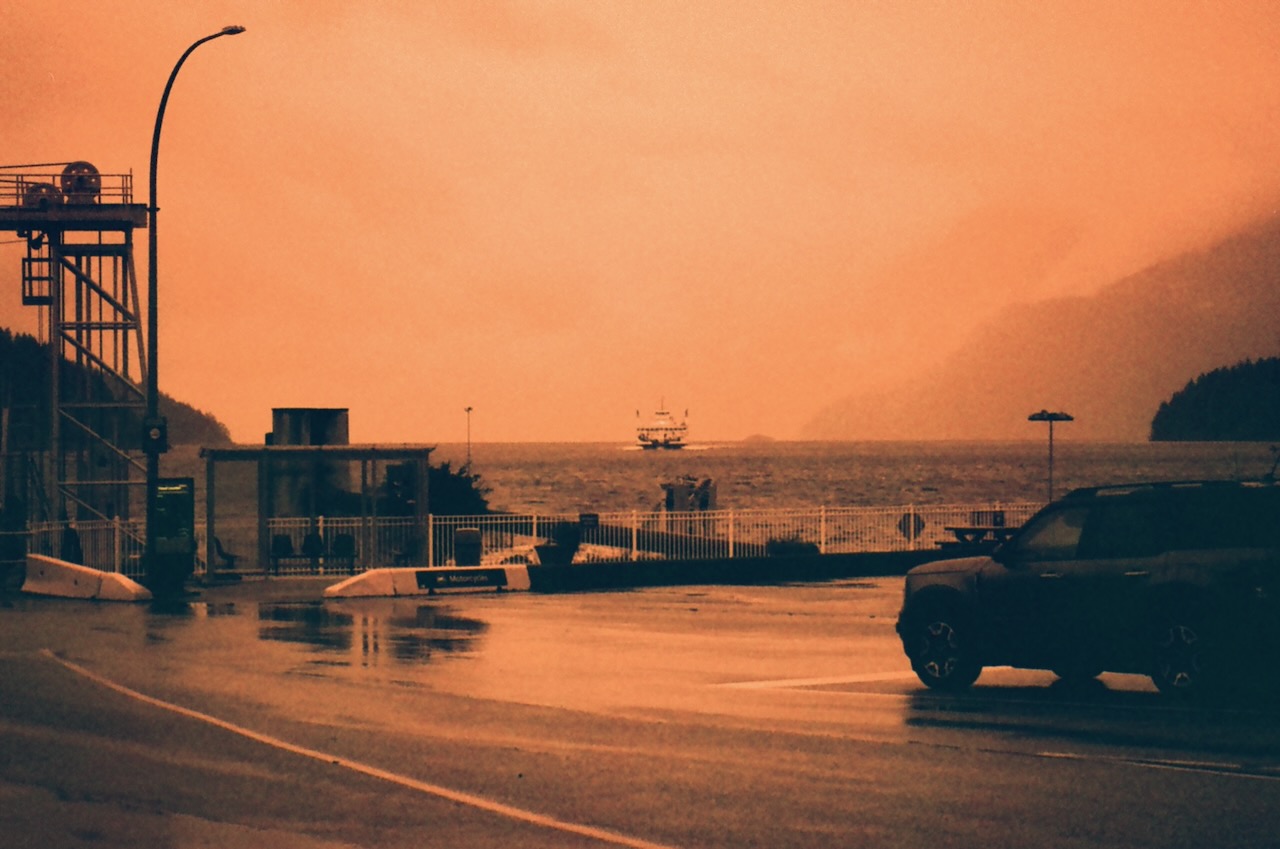
Finally my second favourite photo.
It was really pouring and we made it to Earl’s Cove just so we can see what the other ferry dock looked like. This boat in the distance would take you to the other side to permit you to visit places such as Powell River and then another ferry across the Strait of Georgia to then Vancouver Island.
At the time of the shoot, the sky had an intense grey colour, which was not at all atypical for our part of the world, but the way the film developed the shot left me reminded of how the sky looks during our summers when forest fire smoke makes its way into the south coast.
Such as this example below from when the smoke made its way into Metro Vancouver:
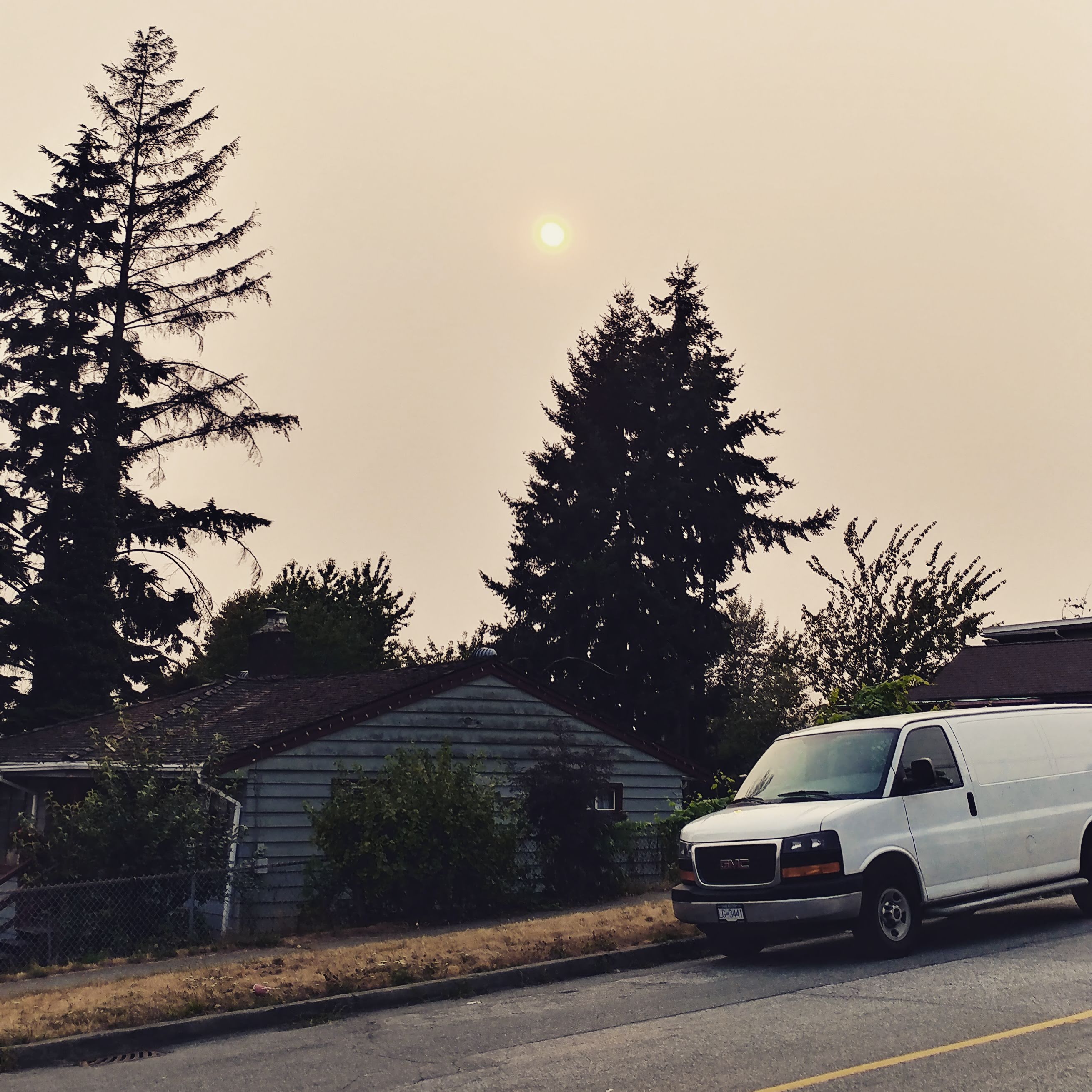
This was taken using an LG V20 smartphone I had back in August 2018. Obvious this produced a very different outcome, but you should be able to understand my willingness to compare.
I look forward to taking more photos. I’m thinking I’ll take shots during a spring or summertime event when I can have a variety of colours available. Right now, most trees have rid themselves of leaves so I’ll wait.
-
A tale of two very different cities
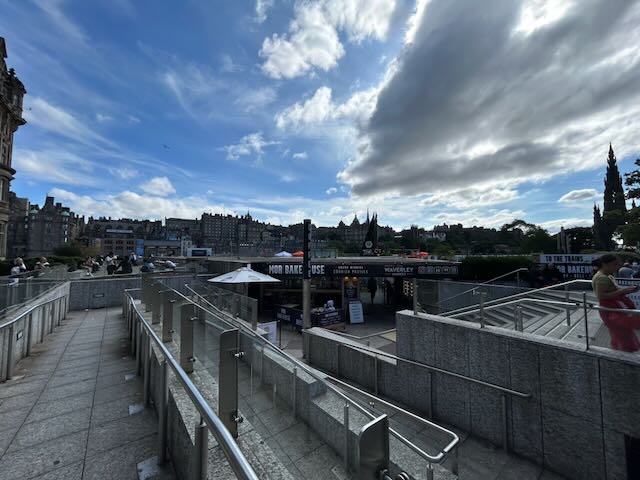
Edinburgh skyline as seen from next to Waverley Station
Last year, I had finally visited Scotland–Edinburgh to be exact. It is a lovely city with an excellent public transport system to the point where Waverley Station–located in a former lake surrounded by the original city centre (or “Old Town”)–became one of my favourite railway stations in the world. The buses and the single tram line made it quite easy for myself to navigate and visit friends during one of the busiest times of the year when the city was hosting the Fringe.
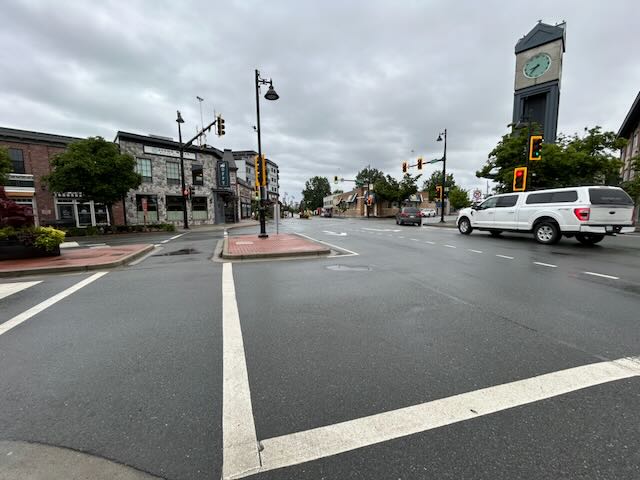
The less glamourous city of Chiliwack as viewed at something I want to complain about
A month prior, I attended a wedding of my cousin and his now wife in Chilliwack, British Columbia. You might find it a bit jarring for me to go from a medieval city with roads barely capable of permitting private automobiles to a rural municipality with its foundings seven centuries after and was built for cars.
The comparisons I can make between the two cities would on the surface be impossible, right?
The simple answer of course is that both have had public transportation at one point destroyed in favour of the automobile and even then anyone would be justified in saying that there’s nothing more. I would agree with that, but there is something Chilliwack has that felt disconcerting to me.
This blog post has lingered in my brain for nearly a year and a half and so to cap off 2025, let me rant about something I found obnoxious in Chilliwack.

Edinburgh city centre during an August evening
Edinburgh’s history starts in the twelfth century, meaning that the concept of the automobile would have been as foreign to them then as interstellar travel is to us now. The concept of the carriage pulled by a horse really didn’t exist in Britain until the 1600s (it did exist during the Roman Empire but had been forgotten), so this was really a space meant for people.
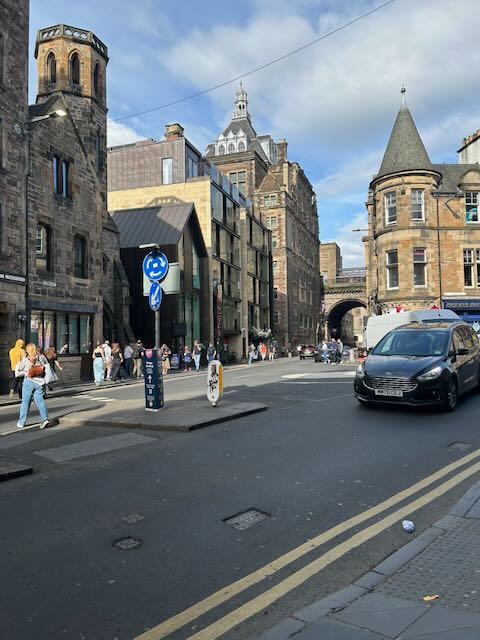
Car travelling through one of the more medieval parts of Edinburgh
Much of Edinburgh is not like this at all admittedly. The Old Town is the original part of the city with New Town being an extension built in the 19th century. The creation of the new area, enabled by advancements made in the industrial revolution are a bit more friendlier to cars, but really the roads constructed were to permit the aforementioned carriages and then eventually trams which saw use from after the first World War until their demolition in 1956 in favour of cars and buses.
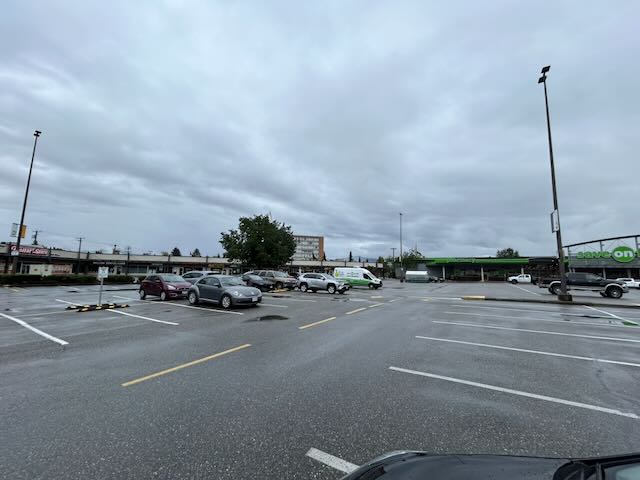
A parking lot in Chilliwack where a supermarket and other business reside
Chilliwack itself is located about a hundred kilometres east of the City of Vancouver. It was first settled by the Stolo (Stó:lō) First Nations some five millennia ago, but was then stolen by failed gold miners in the Fraser Canyon, with them incorporating a town in 1873. Eventually, the city centre was built in 1881 (a year that will become important for later) with its location chosen due to the rest of the city being largely on a flood plain.
With the Canadian Pacific Railway passing through north of the Fraser River from the city as well as in 1910, becoming the terminus of an electric railway from the up and coming Vancouver, this made the area quite bustling and an important centre for commerce and trade.
This is where the parallel between the two cities begin as in 1950, six years prior to Edinburgh’s rapid transit decline, the British Columbia Electric Company, which at the time, oversaw trams and interurban railways in much of the southwestern portion of the province ceased operations to the city, forcing people to switch to modes which used public highways. This has largely remained the case for seventy five years even though Chilliwack does to this day have a one-way railway option.
Chilliwack’s fate was sealed only because it was a city created just in time for the advent of the automobile. This persisted with the construction of the Trans Canada Highway which bypasses its city centre and cuts the city as a whole in half.
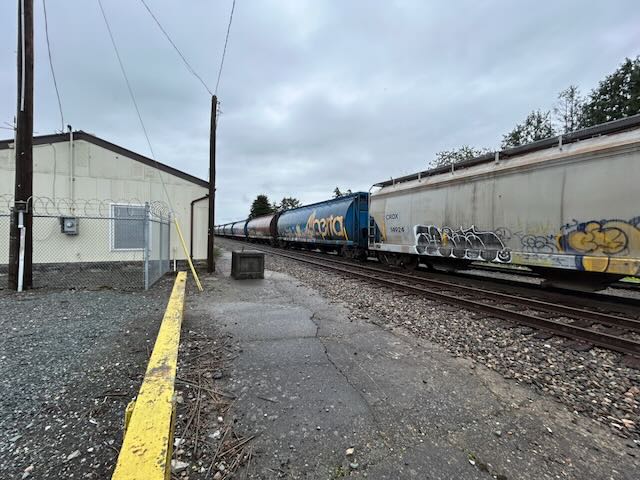
This is in fact a passenger railway stop
To demonstrate how poor transportation options are for non-car drivers, the above is Chilliwack station, serviced by VIA Rail with only two westbound trains weekly. It is located in a very unpleasant industrial estate, has no shelter, and it is only available as a flag stop.
I know “station” is doing some heavy lifting here. If you want to use it, you can book a ticket with VIA and hope that the train arrives at its scheduled time of some weeknight 2 AM as it is subject to the whims of freight traffic.
Transportation is so great in this country.
Public transportation options aside from this include a bus service which while excellent for merely existing, it has no priority and is thus subject to the whims of other motorists, making it less efficient than to drive a car. It is a quite busy route but a lack of funding by and infrastructure from the province and local authorities means it will never live to its fullest potential in its current state.
However, Chilliwack really wants to latch on to something it lost from its past: it wants to be a place where it feels like a lived in setting that doesn’t feel like it’s shackled by the automobile. Born out of “District 1881”, the city embarked on a project to create a neighbourhood that is inviting.
I really feel instead that it is half-baked.
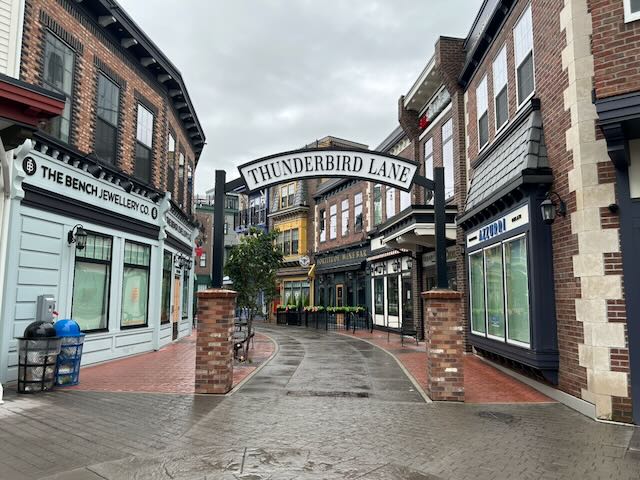
“Thunderbird Lane” located in Chilliwack, British Columbia
This concept of building a walkable area to revive a city centre is nothing new. However, the way that this area was built, it doesn’t feel lived in and even at 8 AM on a Sunday morning on a long weekend, it should be a bit more alive than what the above photo shows.
People like brunch even if they live in a largely agricultural area.
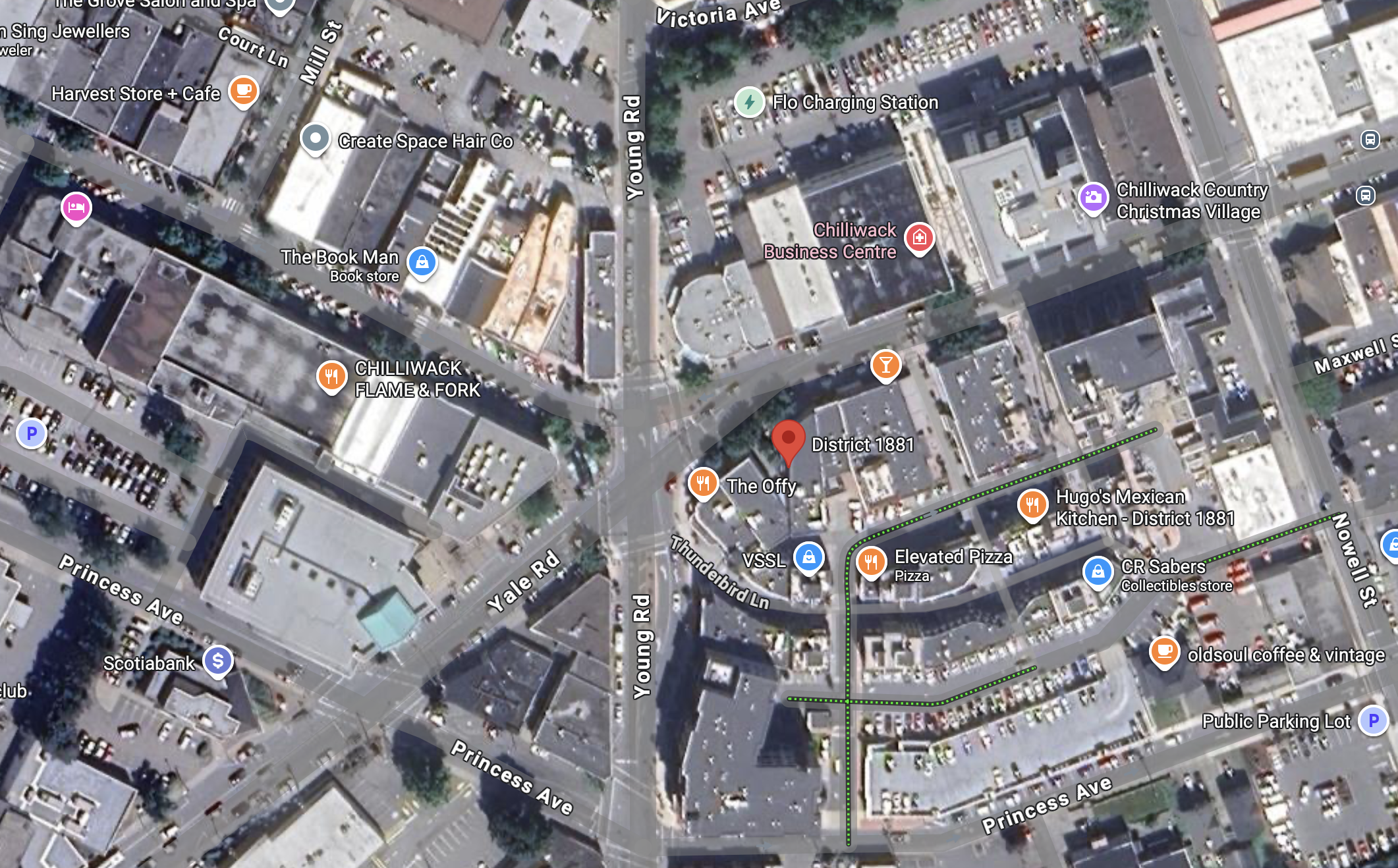
Satellite shot of District 1881
There are two problems that makes this development suffer: the transportation options to and from and the residential or lack thereof around it.
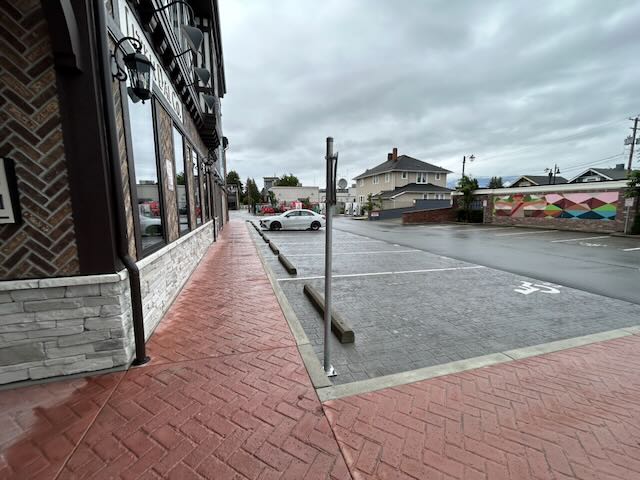
Ample parking day and night
Cars are expected to drive to this place as parking was built into its design. There is a bus that serves the area directly plus another that will connect you back to Vancouver, but the local bus is limited in service with no road priority anywhere to speak of and service ranging from a decent fifteen minute interval on weekdays to a paltry thirty on Saturday and fourty five on Sunday.
The area is walkable I must admit, but once you’re barely a hundred metres out from it all, it becomes low-density housing and that is what really kills the idea of this being anything ideal. One medium density residential building is adjacent to the area and while that is good, that’s it. It’s surrounded by offices that will remain vacant past 6 PM on a weekday and will be nearly absent of people otherwise.
You cannot build such a place and expect it to be lively. The initial novelty of the place has worn off; people don’t want to drive to these places. You have to encourage people to live around them and based on searches for rentals and sale properties, it’s slim pickings if you want to be part of this feeble attempt to revitalise the area.
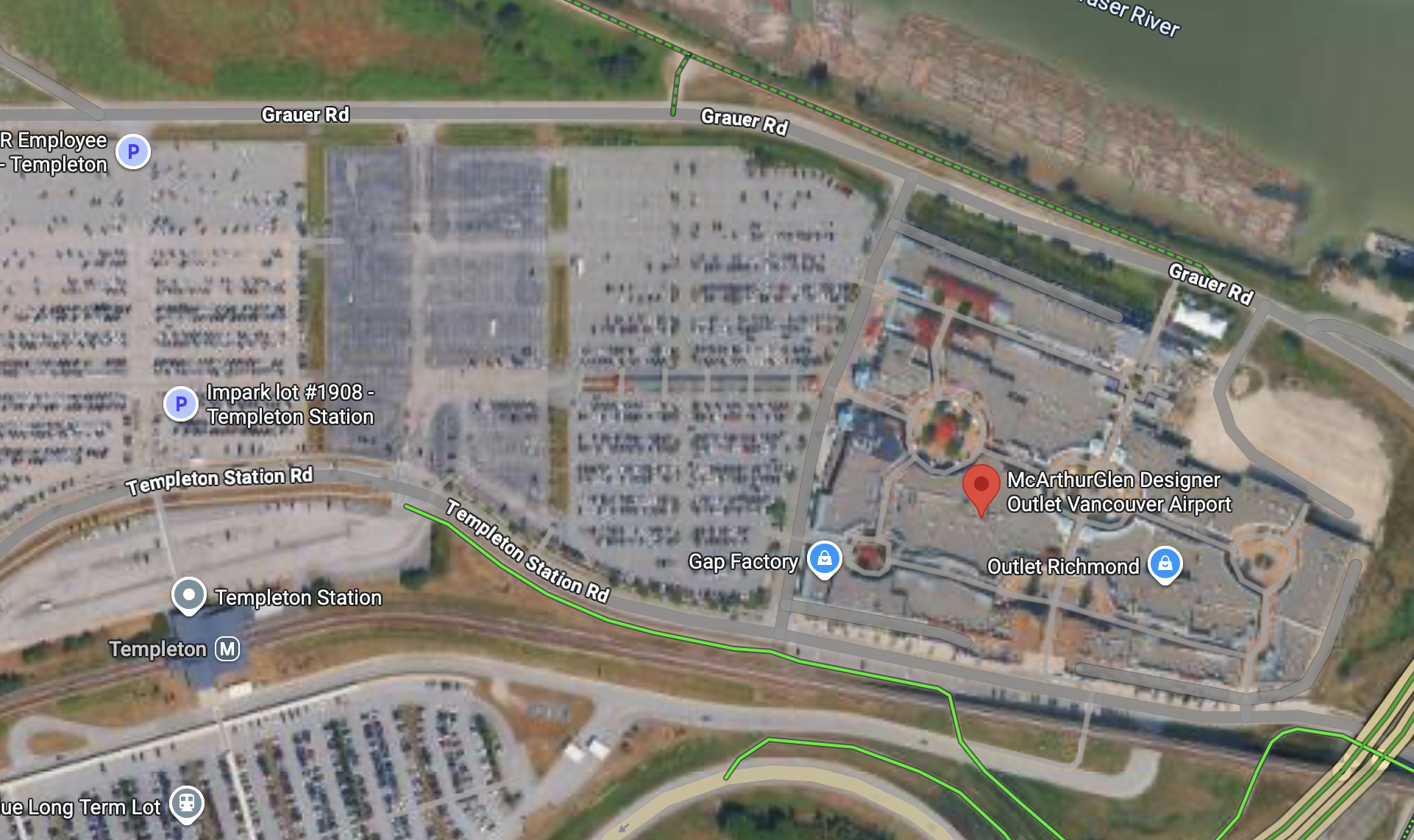
Satellite shot of MacArthur Glen (right) in Richmond, British Columbia with parking to its left and a SkyTrain station (Templeton) to its south
Near Vancouver International Airport, MacArthur Glen is a shopping centre intended to mimic the walkable areas of older European cities such as Edinburgh. It is honestly just a trap for tourists who want to spend their remaining Canadian dollars before going off to the airport and don’t mind planes flying a hundred metres overhead the whole time.
The crime with this place however is that while I may be complaining about the parking given to this project in the Fraser Valley, at least it didn’t have thousands of parking spaces allocated unlike the one that actually was built next to a rapid transit line.
I don’t need an explanation for why as I understand the intended clientel, but it’s still ridiculous.
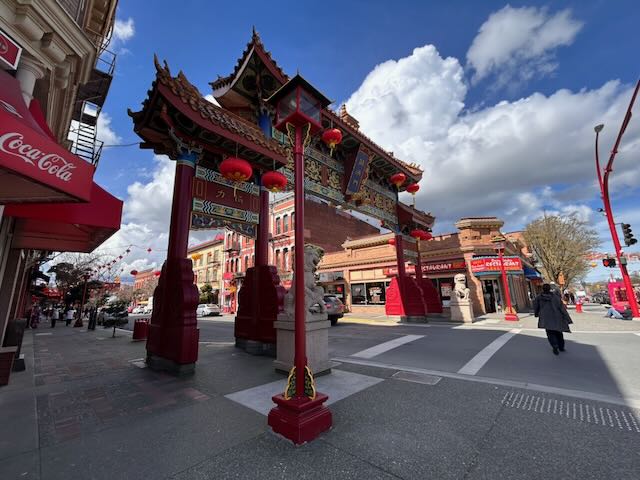
I don’t have any photos of Downtown Victoria so just deal with it here
Now, to be fair, Edinburgh is a city with half a million people and may as well be as many years old when compared to Chilliwack. However, Edinburgh didn’t go and build parking lots to revitalise its city. While it took nearly six decades to begin construction of a new tram line, the initial phase of the project was completed and added character to the city that was sorely missed.
I will repeat myself by saying it is unfair of me to compare Chilliwack to Edinburgh, but District 1881 is a Potemkin village and offers no character due to nothing else being done to support it.
So let’s talk about a population peer that is in British Columbia: Victoria. Both of these cities have roughly the same population (approximately 92,000 for Victoria and 93,000 for the other) and while Victoria may reside in a region with roughly 350,000 people, Chilliwack is part of the Fraser Valley Regional District and it has a similar number of people.
Neighbouring Abbotsford may be more dominant in the region, but there is nothing to say that you cannot have multiple centres. This is the approach of Metro Vancouver and it has worked out quite well for its constituents. If Chilliwack wants to make a project like District 1881 work, it has to make it so it’s not just a theme park for people who don’t realise that there are parts of the world that actually live in spaces like this.
Victoria has density. It has walkable areas. It has adequate transit. It’s not Vancouver and never will be. It is just the provincial capital and is unlikely to ever become more due to its geography.
However, Chilliwack isn’t shackled by its geography and its role in the province is nothing more than a city. Additionally, it also does not suffer from remnants of being the sole eastern Pacific base for the former British Empire. The city could evolve into something more modern if its municipal government actually had some real imagination.
The potential for Chilliwack is that it is the last city in the Lower Mainland before you go east into the interior of the province and then the rest of the country. However, its focus on low density despite all of its growth really says a lot when they say things like this in response to housing targets set by the government:
Coun. Chris Kloot described the frustration: “I think what Chilliwack feels is that we were the poster child, we absorbed growth and did everything in our power to make sure things would go well, recognizing the need for housing.
“And then with the new housing legislation it kind of felt insulting to us, because we were doing all the right things, making room for housing and all the growth.”
Chilliwack’s phenomenal growth is reflected in the 2021 Census numbers that showed Chilliwack was the second-fastest growing city in Canada behind Kelowna, at the time
I have a simple proposal:
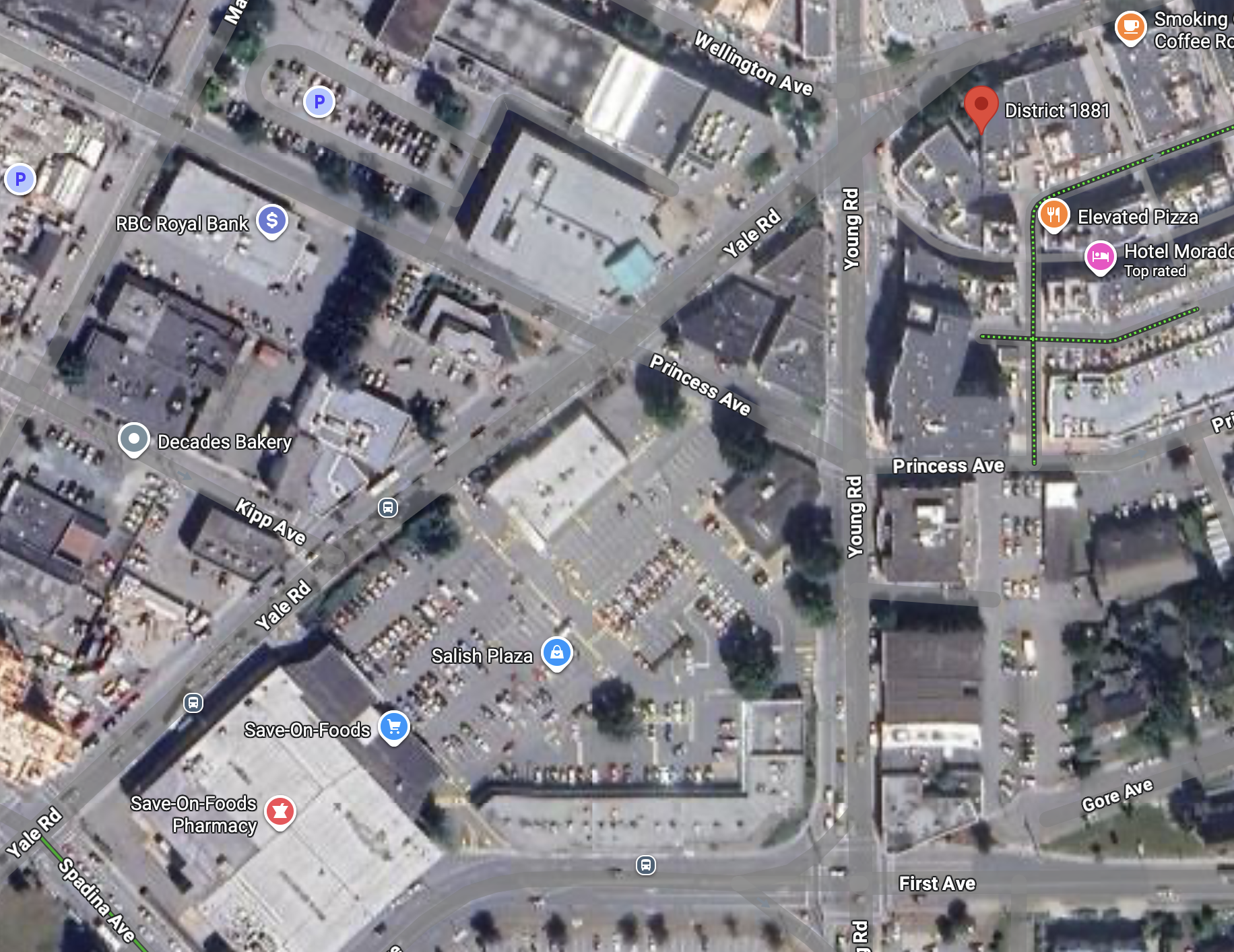
District 1881 on the top-right with a shopping centre parking lot on the bottom-left
District 1881 is 50 metres to the northeast of the Salish Plaza shopping centre. This shopping centre is situated on the former site of the BC Electric Railway’s terminus. The removal of this station and the shift to automobile dependency is the root cause of today’s downtown Chilliwack’s woes.
I am not looking to return this space back to a railway station because it is unlikely to ever happen. Much of the required supporting infrastructure is long gone and any attempts to bring back a railway would be better focused on the station I shared earlier.
However, the fact that this shopping centre remains largely a parking lot and area transit has barely seen any improvement means that projects such as District 1881 will produce a half-baked result and will only satisfy landlords and real estate developers.
Chilliwack and the Fraser Valley deserves better.
-
Comparing Film Purchased on AliExpress

Collection of film with a Fed 3 camera
Some months back I decided to finally make use of my 35 mm cameras and take photos. However, being that the cameras I had were both built in Ukraine SSR, I decided that I should pick up film from AliExpress and use that. This whole process ended up becoming an ordeal because I eventually had to drop the use of my Fed 3 camera due to the fact that its lens plus a lens I stole from a Fed 5 I also owned (which has now become my mother’s) had a problem.

My “new” Nikon F60 just after purchase
Nonetheless, I persisted thanks to a purchase of a new-to-me Nikon F60 and took a number of photos with an assortment of film purchased from the Internet’s bargain store. Most of the photos were taken during a single weekend where I watched my softball team play in our year-end tournament–sadly without me playing due to an ongoing knee injury.
It had been since 1997 or 1998 since I got any film developed because I never really developed an interest in photography until I was in university in the 2000s. Please ignore how ignorant I am about film as I learnt everything on digital first.
CHINA LUCKY SHD100
Cost: C$14.48 Exposures: 36 ISO: 100 Cost per exp.: C$0.40
This is the only roll I used on my Fed 3. Now, you may be wondering, how did I know that the lens was scratched before getting it developed? Prior to placing this roll into this camera, I got some film shot on Ilford stock and it disappointingly had some rather unusual marks on the lens.
Now a Fed 3 and Fed 5 both use an M39 mount for the lens, so you might think that I could have done that with the Fed 5 I was going to give away and you’re right. However, I did take photos with the other camera as well and it too had some weird scratches.
Chalk that up to buying cameras on eBay and not testing the lenses, but alas. I did at least get some shots which contain the scratch pattern you see here.

Image showing some leaves on a tree in late-July
As evident here, it’s a bit grainy but overall not too bad. The contrast is quite apparent and you can tell the leaves apart. However, you might notice the middle of the image is blurry and that is not the fault of the film.
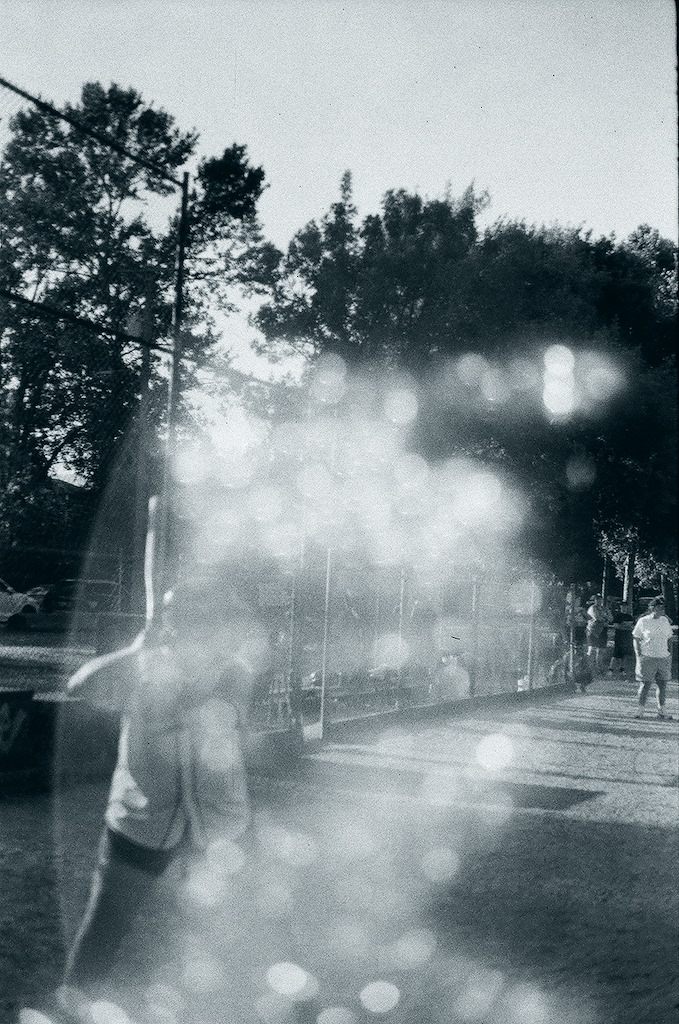
Teammate up to bat with the lens scratch in the middle
It seems to struggle with the sharpness in the shot, but I honestly think it is just me not having the image at all in focus properly, which is a problem when you’re trying to use a rangefinder for the first time after being used to using a DSLR. That scratch is super apparent and the one on the other lens is not much better.
Moving forward, all photos were taken with a Nikon F60 which does not at all have any problems with its lens–even if it did, I have other lenses anyway.
35mm Color Print Film Professional Wide Exposure Range ECN 2 Process Colour
Cost: C$6.44 Exposures: 8* ISO: 200 Cost per exp.: C$0.81
Oh boy. Where to begin? This film may never be developed for a variety of reasons.
First off, in its description, it cannot decide between the American spelling and the spelling of “colour” we in the rest of the English-speaking world use. However, that is really a minor nitpick here because you might have noticed an asterisk on exposures.
It says it does eight, but my camera only got two images out of it. The autorewind kicked in after two shots and that was that. Maybe it had to do with the short roll, but that was only part one of two with my experiences here.
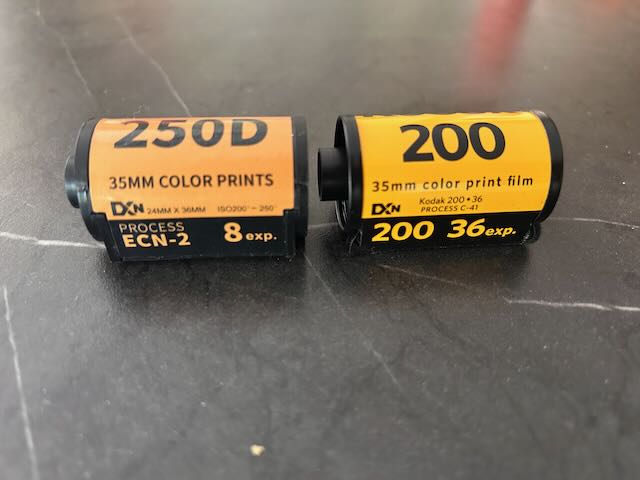
Image of the roll compared to a similar-looking Kodak one
When I took the roll to be developed, the clerk at the counter was rather perplexed by it. First of all, she initially thought it was a Kodak roll which of course in the above image you can clearly see it tries to mimick. In fact, it looks like a Kodak roll I later used as a “control” for a lack of a better word here.
To add to this, the film process was something unfamiliar to me: ECN-2.
When speaking to a friend online about it later, she remarked that this film is coated with an extra layer atop that when processed as any other roll would gum up the processes. This was something she had first-hand experience with and it’s apparently not super common.
The clerk had to refuse the roll as a result. Of course, when reviewing the listing, this stood out.
- Universal to Use: 35mm color print film is also suitable for portrait and fast action photography. Suitable for 135 cameras.
“Universal to Use” is taking quite a bit of a stretch because while it worked fine in my camera, it’s quite a pain in the ass to get it developed by anyone reasonable.
Now, I did not go and take this sitting down so I went to see if anyone local would get it done. Looking around, it seems like nobody does it locally and I would have to learn to develop this film by hand. I do not have that confidence yet and considering that if I do find someone to process the film, it might not be worth it for just two exposures.
Having seen what photos taken with ECN-2 look like, I can sure tell you that this is disappointing because where it is used is for motion pictures it makes some rather stand-out photos.
35mm Black and White Print Film
Cost: C$10.18 Exposures: 8 ISO: 200 Cost per exp.: C$1.27
I have since seen “My Heart” available for sale in some gift shops locally. It is the most expensive per-exposure film I have gotten developed, but the quality did not look too bad.
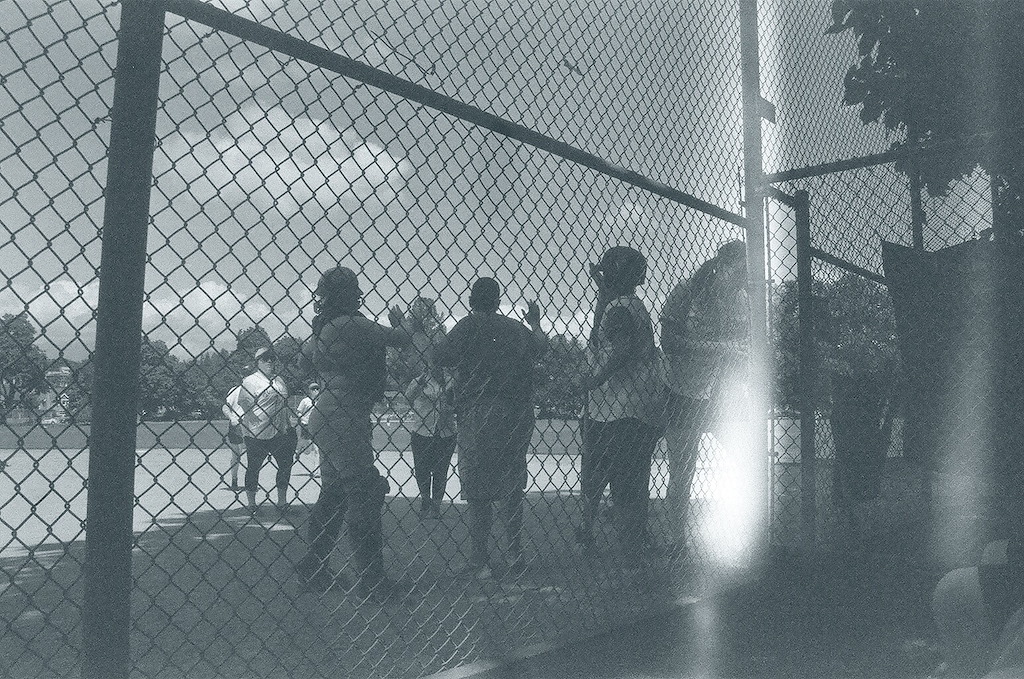
Teammates coming in after an inning is over
It is lost on me why there is a ghosting pattern on the right as it does not appear in other shots, but I have to wonder if this film was actually ISO 200. I was taking a photo from a shaded area which might have produced a darker image, but it wasn’t that dark when thinking back to the time of day.

Teammate pitching the ball
When the lighting cooperates, the detail on the jersey comes out quite decent considering I was maybe eight to ten metres from the woman throwing ball. The ball itself looks fairly static but it is evident that it itself is moving fairly fast–maybe 40 KM/h at this point, we’re in the second-lowest level for this league after all.
However, at this price point and number of exposures, the film overall is underwhelming.
So the way I ordered it off of AliExpress, it was super confusing because at C$10 for the roll, it was easily the most expensive not only as a standalone roll, but by exposure, but the page itself was super misleading because was it eight rolls when indicating “pieces” or were they just using “pieces” to mean exposure?

In any event, this is something I am noticing when ordering film on AliExpress so just bear that in mind if you’re going on a photo adventure with strange film from abroad.
VIBE 400 Black & White film
Cost: C$5.97 Exposures: 36 ISO: 400 Cost per exp.: C$0.17
Is this a European or Asian brand? Well, it’s the only one I can find about on Wikipedia and it’s probably my favourite out of the four I purchased.

Plants on my window sill at home
This image is sharp and the grain adds to the photo instead of subtracting like I have seen before. Even in the shaded areas, you can still make out detail.
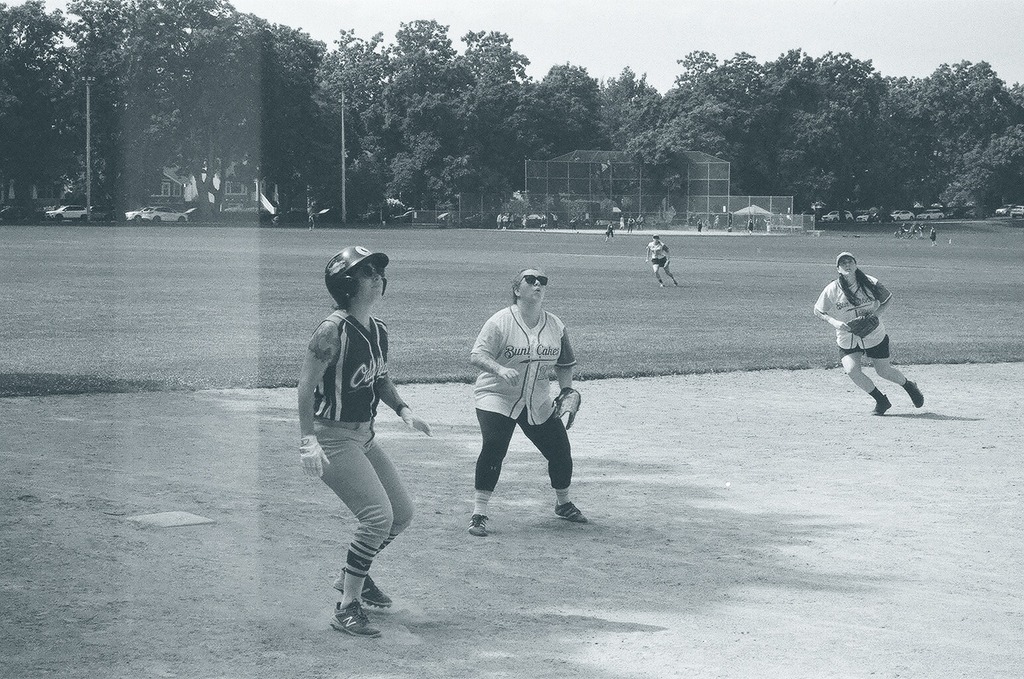
Shot of teammates on the field with one running and one waiting, and a player from an opposing team looking upwards.
I believe that the banding on the left might have to do with the the development process as it shows up in the negatives, but that aside, you can see so many details in this one shot. The player on the right is moving quite fast (she is a fairly speedy runner) and even though it is quite sunny, the gravel on the softball diamond is still showing its texture.
Kodak Gold 200
Cost: C$21.26 Exposures: 36 ISO: 200 Cost per exp.: C$0.59
This was purchased from a local retailer due to my running out of film. Kodak Gold 200 is pretty standard film to come by in Canada and is perfect for sunny days and softball tournaments.
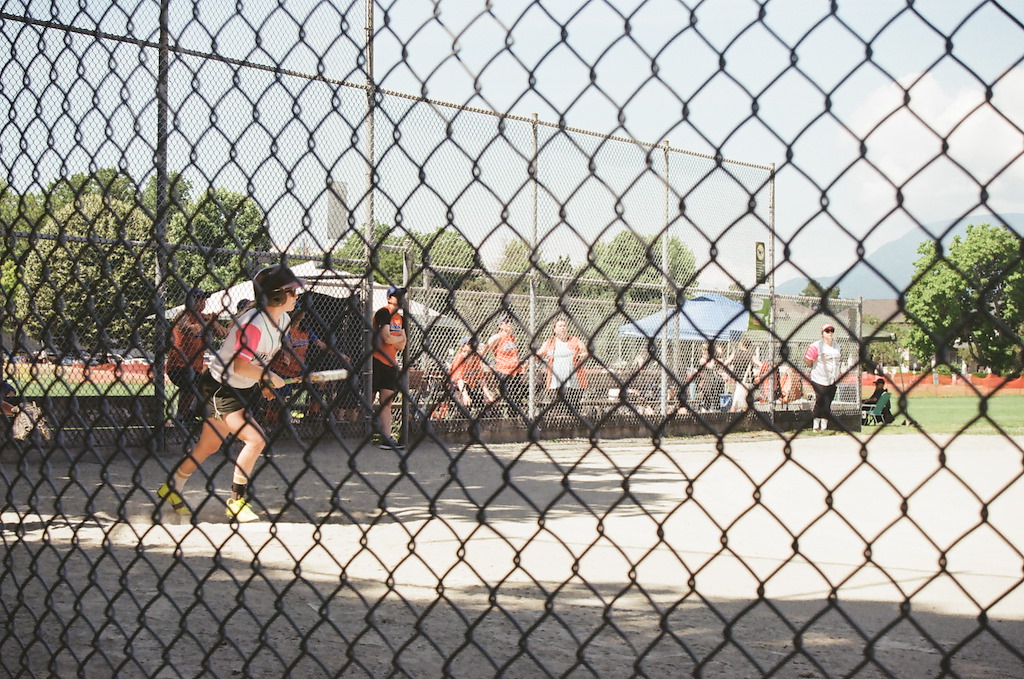
Player after having hit a ball and initiating running towards first base
One of the things I noticed that gets lost in colour photography is that sometimes little details just get washed out. I mentioned with the Vibe 400 film that you can make out detail in the gravel around the diamond, but in this shot and the one after, it is just washed out by the light. This could be a consequence of the ISO I must admit, but even then I think it would still be clearer if this shot were to have been taken on non-colour film.
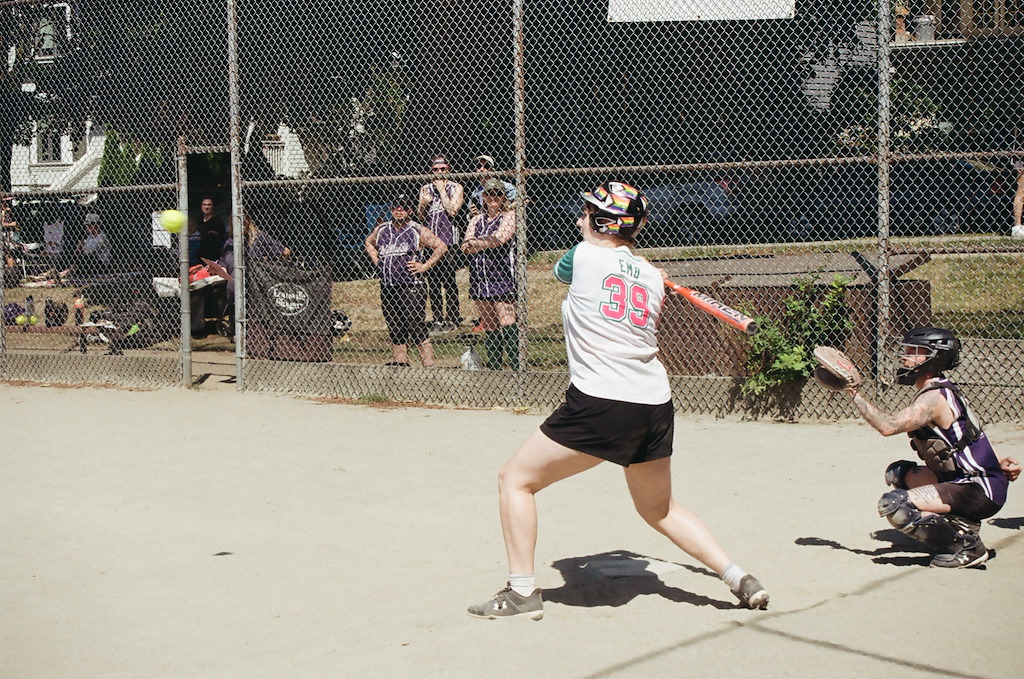
Softball player having just hit a ball
This was only shared as a “control” so to speak just to confirm that yes, my camera was working fine.
Conclusion

Collection of rolls of film plus some bonus ones that are not the main focus of this post
This was a silly exercise and taught me a lot about film and its differences. One big thing I didn’t anticipate is how some rolls of film have something called DX encoding which tells a camera everything from its speed (ISO), length, and exposure tolerances.
Of course, with the Fed 3 and 5 cameras, there is no need to worry about this because there are no digital parts on the cameras to read it so you have to do thsi sort of work manually. However, my F60 understands this encoding and would refuse to take photos if said bars were not there. I had stickers to force the camera to use the film fortunately, but one of the rolls only had it printed on instead of having a metal coating.
I wish I had made note of which one it was but it might have been the funny ECN-2 one, which might explain why it only got two shots out of it, but I digress.
If I were to buy any of these rolls of film again, I absolutely would buy the Vibe again. They’re fairly inexpensive and cheaper than the Ilford I’ve used in the past, and I’d argue that they’re slightly better quality. However, if I were to go through this exercise again, I’d definitely try different film and stay away from anything that requires a weird development process.
Should you be one of my friends reading this and are interested in trying out ECN-2 developing, let me know and I’ll be happy to send the roll your way to find out what the two shots ended up looking like.
Lastly, I will be sharing more photography stuff on this blog in the future. Taking photos with 35 mm film has been an enjoyable hobby so far and is unlikely to ever be polluted further by technology the way we have seen with digital cameras today. They’re as pure as you can get for technology-based hobbies and I hope that it remains that way.
-
The Mark V is the future of transportation in Metro Vancouver
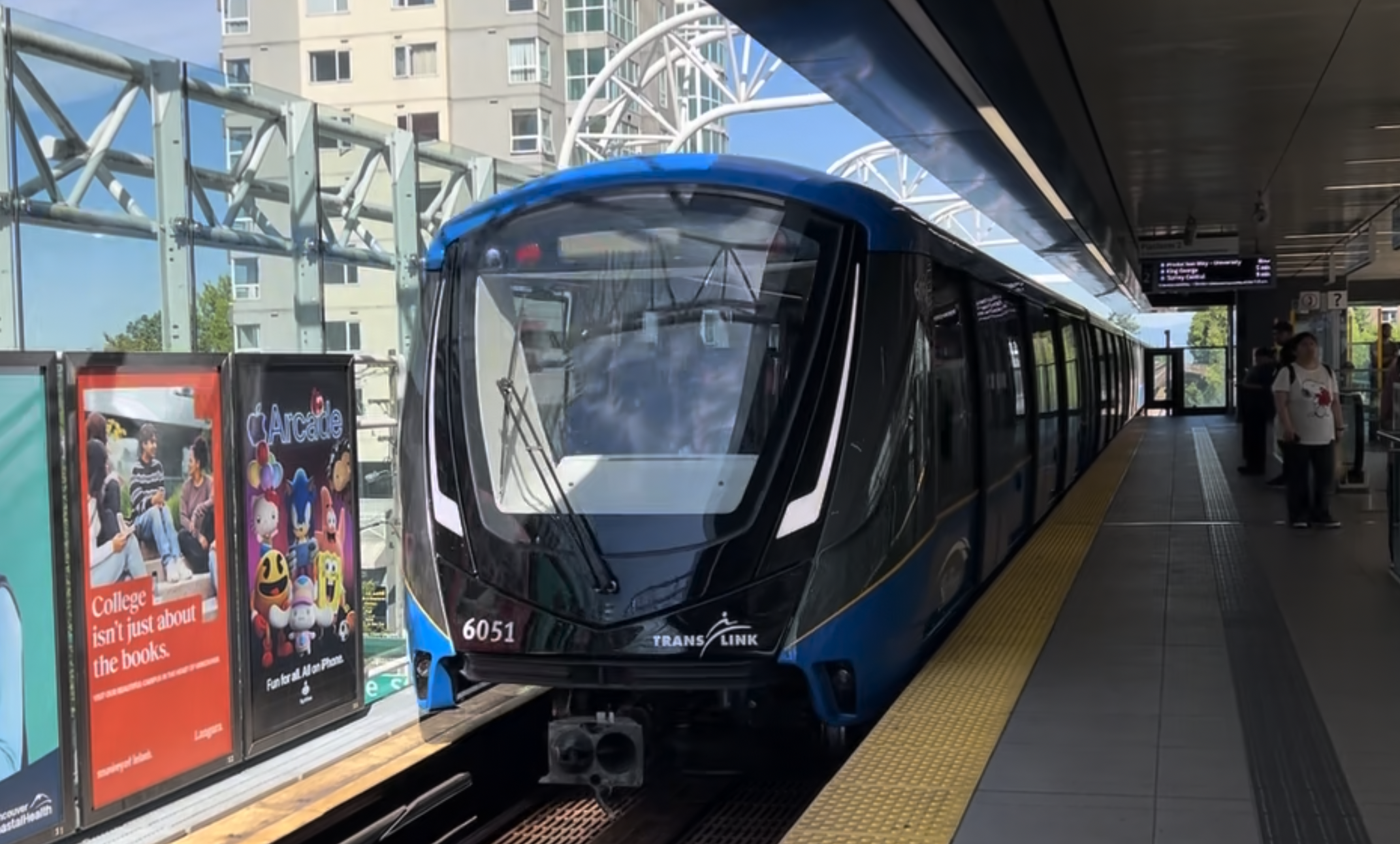
SkyTrain Mark V arriving at the station
Sorry for the lack of posts for the past while. I have been unbelievably busy. Enjoy this new blog format!
I had the fortunate luck to catch a brand new Mark V over the weekend and I have a lot of thoughts on why this train is good and why we’re sort of at the end of Expo Line expansion. Overall the train is really good and iterates well on four decades of experience by local transit officials.
Since then, some thoughts have been percolating in my head over what these trains mean and what I think the future holds for the SkyTrain system as a whole.
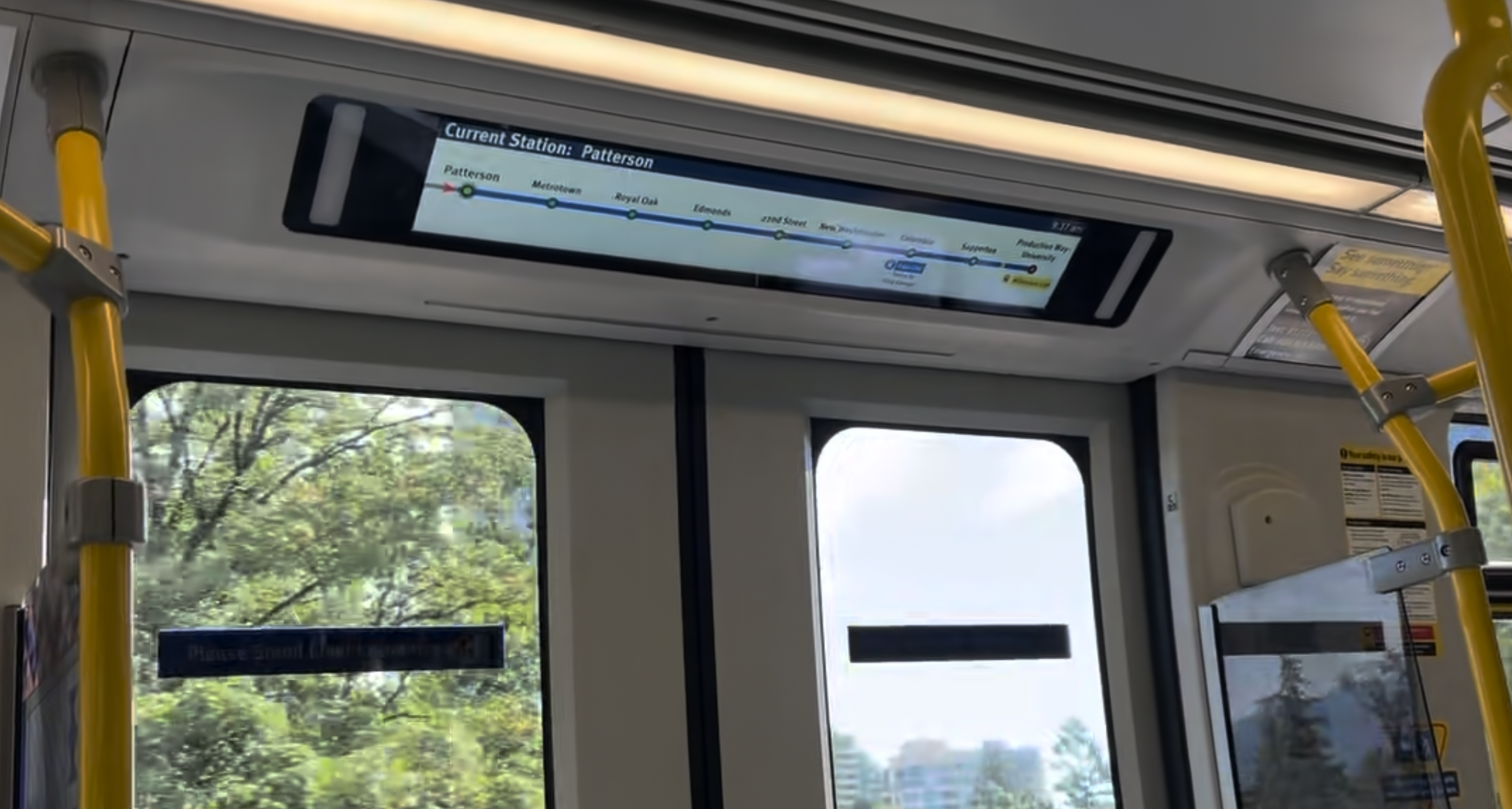
Interior of a Mark V showing the next station
The Mark V came into service last week here in Vancouver. What makes them special is not the LED displays which show all sorts of useful information nor the wonderful indigenous art laminating the glass dividers between the doors, but it is the length of the trains.
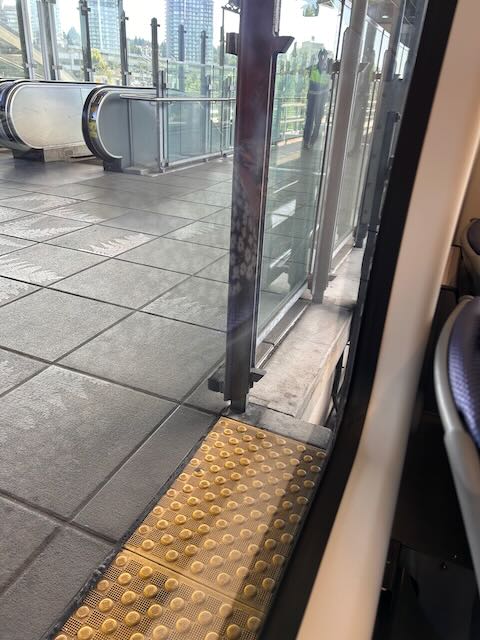
Train interior looking outside showing the train at the very edge of the platform
These trains now occupy the full length of the platforms on the Expo and Millennium Line. Getting to this point has taken 40 years since the opening of original Expo Line, which tells you a lot about how forward thinking we were thinking with everything then—I wish the same could be said for the Canada Line, but that is a whole different topic.
When I made an appearance on Gareth Dennis’ podcast, Railnatter, I pointed out that the Expo Line once the new extension is completed will put it at just six kilometres short of the Northern Line in London (58 KM compared to Expo’s future 52), to which he had a bit of a negative reaction to.
His reaction was right because it’s actually the city’s busiest line. I’ve had the ‘joy’ to use the Northern Line while working in London and it’s not a pleasure to be on. There is no real alternative to the line when it’s busy and many of the stations are either really crampt with narrow platforms or have interchanges that will test your claustrophobia—try Bank between 4 and 7 PM on a weekday and you’ll quickly understand.
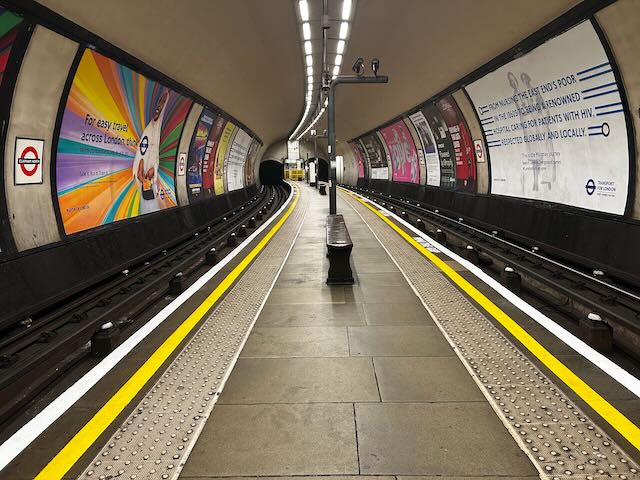
Interior of Clapham North on the Northern Line, which is something like 2-3 metres wide platform-wise
There are very few metro systems in the world that have lines that exceed the Northern Line. San Francisco has one BART line that exceeds 100 KM, but its excuse is that it’s hemmed in by geography and operates in a very non-metro-like way I find.
China has two systems that are between 800 and 900 KM total trackage, but only Shanghai’s has three of which exceeds the Northern Line—and unlike the BART, the redundancy in the system is quite apparent.
So why do I care about the length? It’s simple: capacity of the system. You can only move so many people on these trains comfortably and metro systems are not meant for long distance travel. I am a bit baffled at Chinese systems doing 80-100 KM, but I am certain it works for their use cases and provides a heck of a lot of redundancies, but it will not here.
These trains are going to be maxed out by the time they finish passing through Surrey. While commuting patterns have shifted in the years towards staying within Surrey, the two largest economic centres remain downtown and Broadway, both of which are in Vancouver and are already on the system or will be before the Expo Line expansion completes.
Even at north of 600 people per trainset and even if you were to push the 70 second headways the system is capable of achieving, these sort of trains are meant to be for short journeys despite how many people it’ll move. This is what our system was designed with and there are only a few examples where you can buck this trend.
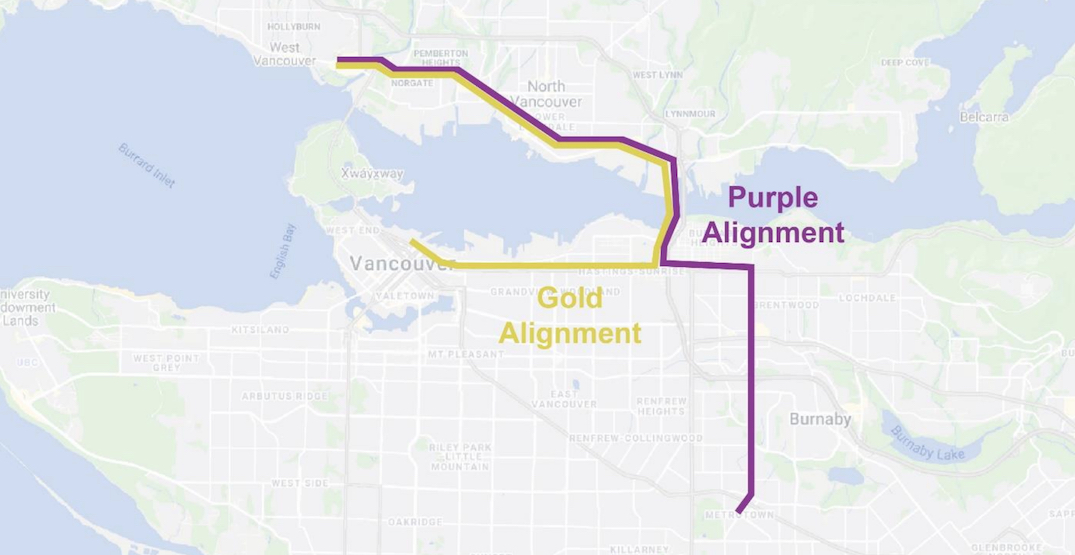
Two potential routes for SkyTrain in Vancouver going to the North Shore
We’re never going to really go much east beyond the terminus being built at Langley Centre. Perhaps the Expo Line will be part of the extension to the North Shore, but it’s looking like the powers that be in Victoria don’t want that and quite honestly I think it’s the right idea at least for now.
What about the rest of the valley then? Aside from maybe an extension of the Millennium Line out to Pitt Meadows or Maple Ridge, which really would run into the same problems as the Expo, we’re probably looking at alternatives from SkyTrain when trying to get out there from the western shores of the region.
I have made remarks around this problem in the past both in video and written form, but as it stands, your options for getting to Abbotsford or Mission for the most part relies options such as taking a crowded bus that runs hourly, riding a train that only leaves from the valley in the morning to then return in the evening, or driving a car.
The West Coast Express is a really pathetic system even though it does punch above its weight all things considered.
If this region is going to grow, if we’re going to resolve our housing situation, and if we’re going to reduce our greenhouse emissions, we’re going to need to think big and also systematically.
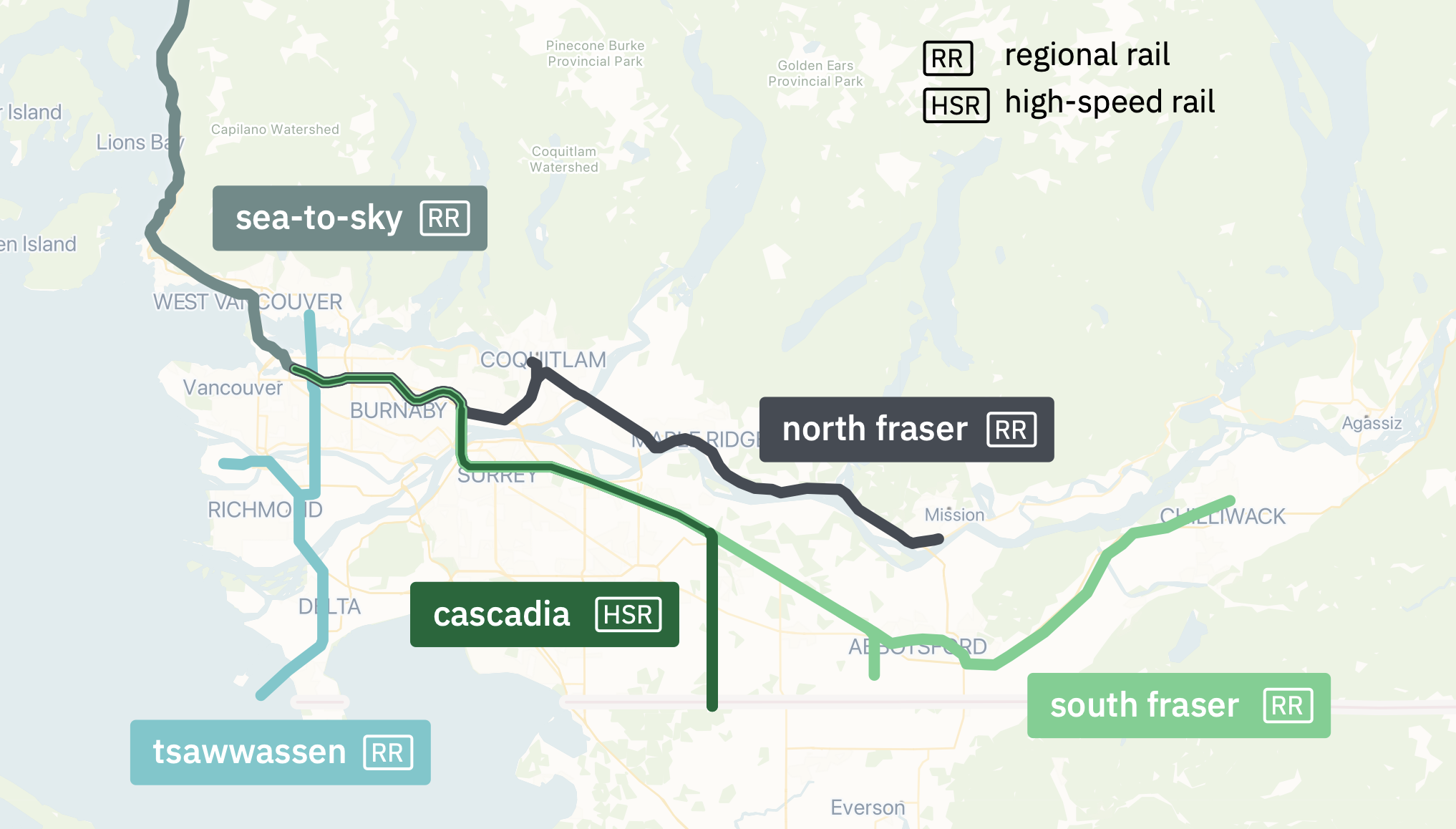
MVX and its grand vision of regional rail going into the Valley and even towards Squamish and Whistler
Buses are one part of the solution (the Fraser Valley Express operated by BC Transit is a great idea), but I think we need to get more serious with high volume movement of people. The folks behind Mountain Valley Express have the right idea, but it’s going to be a waste if we don’t align everything around it. We did this with SkyTrain back in 1985 and we will have to do this with any new mode of transportation in the future.
If we’re going to go on an infrastructure building spree in this country, let’s get people moving en masse. The Mark V is a symbol of the progress we have made and the progress we have to still make.
Also, to close off: good riddance to the Mark Is. They were good for the time, but they’re rubbish now and I am glad to see TransLink slowly taking them out of the system. I’ll be pleased to see them as heritage vehicles periodically, but I look forward to never having to be forced to ride in them again.